View course on architecturalrecord.com »
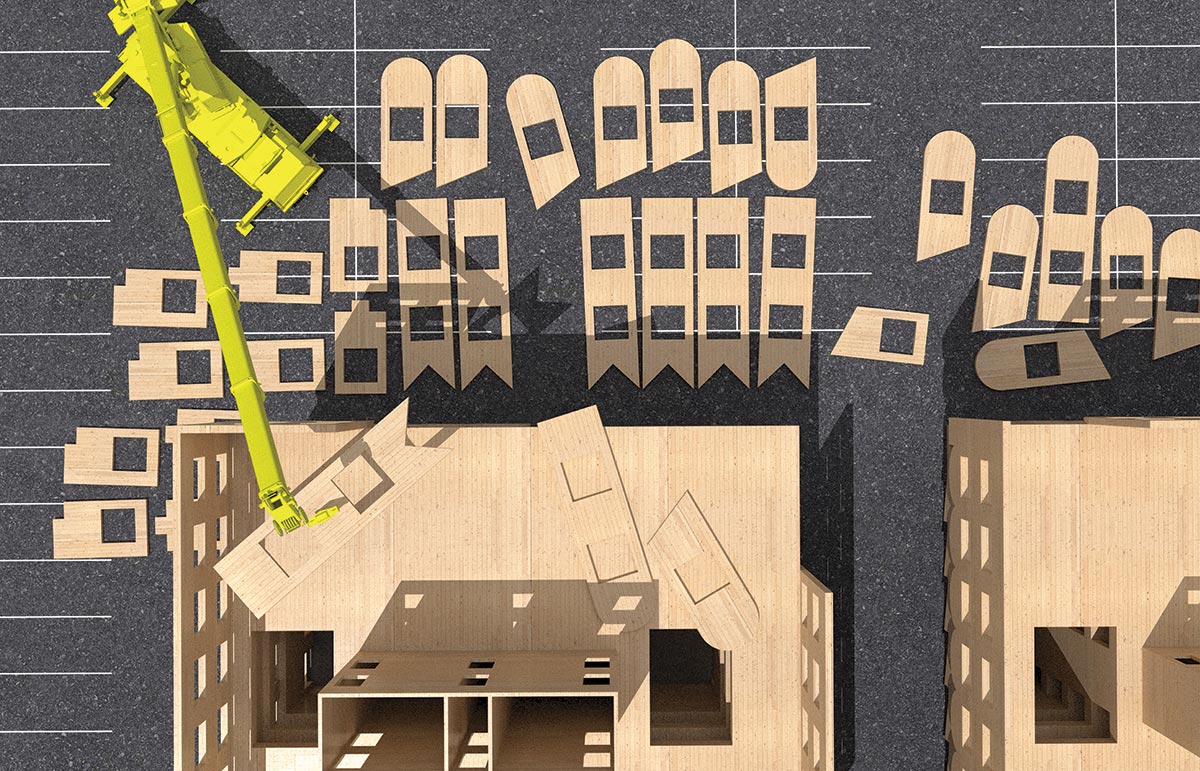
Photo Courtesy © JENNIFER BONNER/MALL, TOUCH WOOD, LARS MÜLLER PUBLISHERS
“4 Over None” is a pitch to developers, by the firm Mall, to flip the formula from “5-Over-1” (multistory wood construction over A concrete podium) to Type IV (heavy timber).
Building with wood is on the rise—and we’re talking large-scale projects and even infrastructure. This special section examines the forces driving the demand for timber construction: the policies in place to encourage its use, advances in its engineering to suit unexpected building types and locations, and efforts to source it sustainably.
To better understand what it means to build with wood, architects start in the forest
BY JOANN GONCHAR, FAIA

Image © SOM
SOM’s COB3 has a frame designed for disassembly.

Photo © Cesar Rubio
Wood is an ages-old construction material—but it is one that is receiving renewed attention, especially with the rise of mass timber. This group of engineered-wood products offers the possibility of, rather than extracting the raw materials for our buildings and cities from the earth, growing them instead, capturing climate-warming greenhouse gases in the process. But is timber always good for the environment? Or is it simply less bad than mineral-based materials such as concrete and steel?
Answering these questions is far from straightforward, but it starts with where the wood is grown. Managing a forest sustainably involves balancing productivity with protection of water bodies, preservation of wildlife habitat, and consideration of carbon and climate. “Exemplary forestry is a holistic look at all three,” explains Jennifer Shakun, bio-economy-initiative director of the New England Forestry Foundation, a land trust and conservation organization.
One tool that can help determine if a wood product originated from such a forest is certification. The most dominant wood-certification labels in North America are those administered by the Forest Stewardship Council (FSC) and the Sustainable Forestry Initiative (SFI). These programs take into account such factors as the size of clear cuts, levels of live-tree retention, pesticide use, and the protection of threatened and endangered species. Of the two, FSC is considered the more stringent, with SFI-sanctioned practices being equivalent to what Canadian and U.S. regulations already require. “FSC is more robust,” says Amy Leedham, U.S. carbon practice leader for sustainability consultancy Atelier Ten. “It addresses more criteria in more depth,” she says. But there is a rub: FSC products are not always available, and the certification process can be expensive, putting it beyond the reach of small private landowners and tribally managed forests.
The best management practices promote forest ecosystems that sequester more carbon. However, estimating just how much biogenic carbon is in any given wood product is tricky. One reason is that most life-cycle assessment (LCA) calculators—tools that quantify the environmental impacts of manufactured products—use national data sets that do not account for the wide variation in practices at individual forests. “With current LCA tools, it is hard to understand the underlying assumptions,” says Jacob Dunn, a ZGF associate principal. In collaboration with the University of Washington’s Applied Research Consortium, the firm is trying to remedy this situation through its UpStream Forestry Carbon & LCA Tool. Currently in public beta testing, the open-source calculator aims to make underlying data transparent and easy to manipulate. “The idea is to help designers better understand the dynamics between the forests and the wood products that come from them.” Given current limitations, one of the best ways for architects to get a handle on where the wood products they are specifying are coming from is to work directly with manufacturers, asking them detailed questions. For instance, the team behind COB3—a $230 million SOM-designed mass-timber office building for San Mateo County, nearing completion in Redwood City, California—evaluated potential fabricators for the building’s custom-engineered cross-laminated timber (CLT) floor panels. They researched manufacturers’ capability for panel size and limitations on bearing capacity, but also investigated their supply chains. The Montana fabricator eventually selected was less than a mile from the forest where the timber was harvested and was next door to another plant making fiberboard from CLT scraps.
Increasingly, project teams are tailoring the wood-sourcing process to reflect the priorities of their clients. Portland, Oregon–based LEVER Architecture did so on the $10.8 million 19,800-square-foot headquarters it designed for the grant-making organization Meyer Memorial Trust (RECORD, March 2021). Completed in 2020 in Portland’s Lower Albina neighborhood, the sawtooth-roofed building has structural components fabricated primarily from mass plywood—a large-scale engineered panel made of wood veneers. The building also incorporates numerous other wood products, including roof trusses, flooring, and ceilings. For Meyer, the construction process and the procurement of these materials was an opportunity to advance its mission of racial, social, and economic justice, particularly in Oregon.
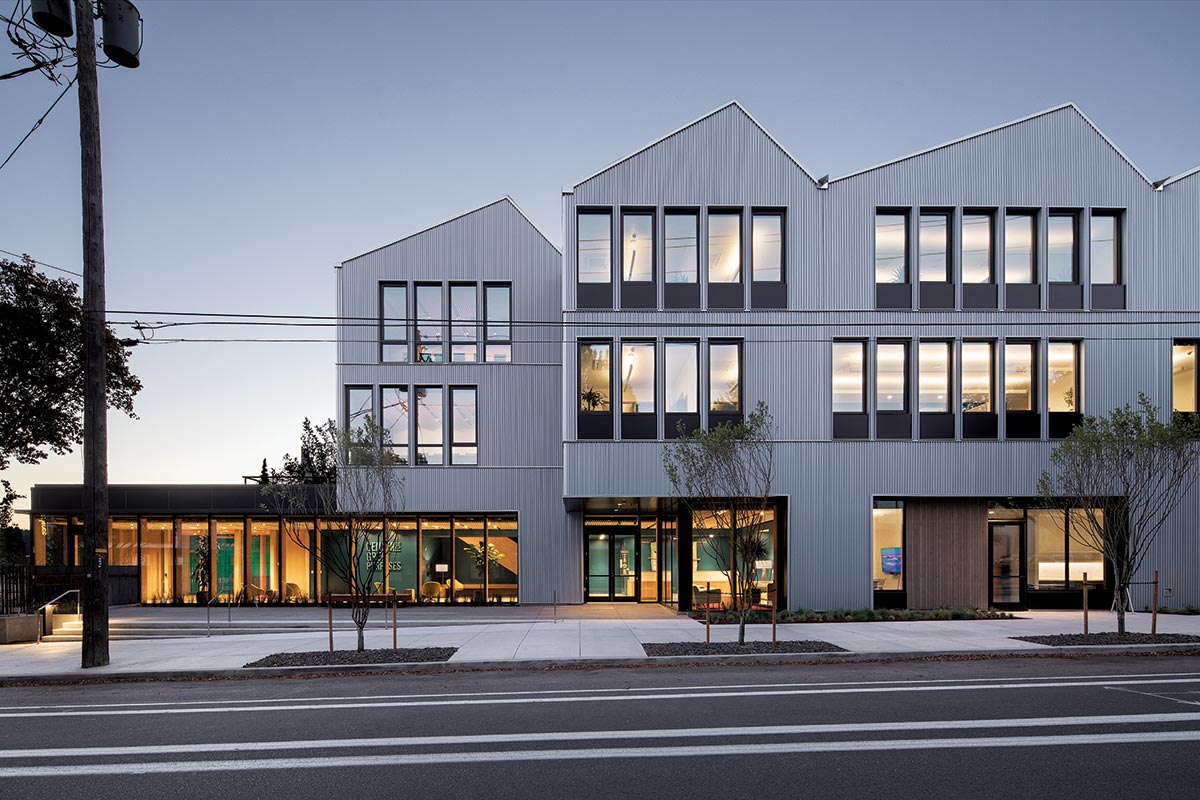
Photo © JEREMY BITTERMANN
The sourcing criteria for LEVER’s Meyer Memorial Trust project reflected the values of the owner.
Meyer worked with the nonprofit Sustainable Northwest to develop procurement guidelines that went beyond forestry and manufacturing processes, also considering a supplier’s proximity to the site, minority and small-business ownership, and cost. The premium for this strategy was negligible, amounting to less than $25,000, or about three percent of the $745,000 wood package. But the modest investment had an outsize impact. Over the building’s 12 categories of wood products, 10 were grown and manufactured in Oregon. Minority-owned companies were involved in the purchase and installation of six of the 12, while small businesses were responsible for seven. Nine of the products were sourced from forests that were determined to be ecologically managed. The project influenced sites beyond the building, says Thomas Robinson, LEVER founder.
The revamp of the main terminal at the Portland International Airport is another project with custom-tailored sourcing criteria, but one that is taking the approach to a whole new scale. Designed by ZGF, the $1.8 billion expansion, currently under construction, has a 380,000-square-foot wavelike roof being built from over 2.6 million board feet of glulam beams and 400,000 square feet of mass-plywood panels. For the terminal’s owner, the Port of Portland, transparency and traceability were key. “They wanted to know the timber’s local story,” says Dunn. “They wanted to know who owned the land and how they were stewarding it,” he says.
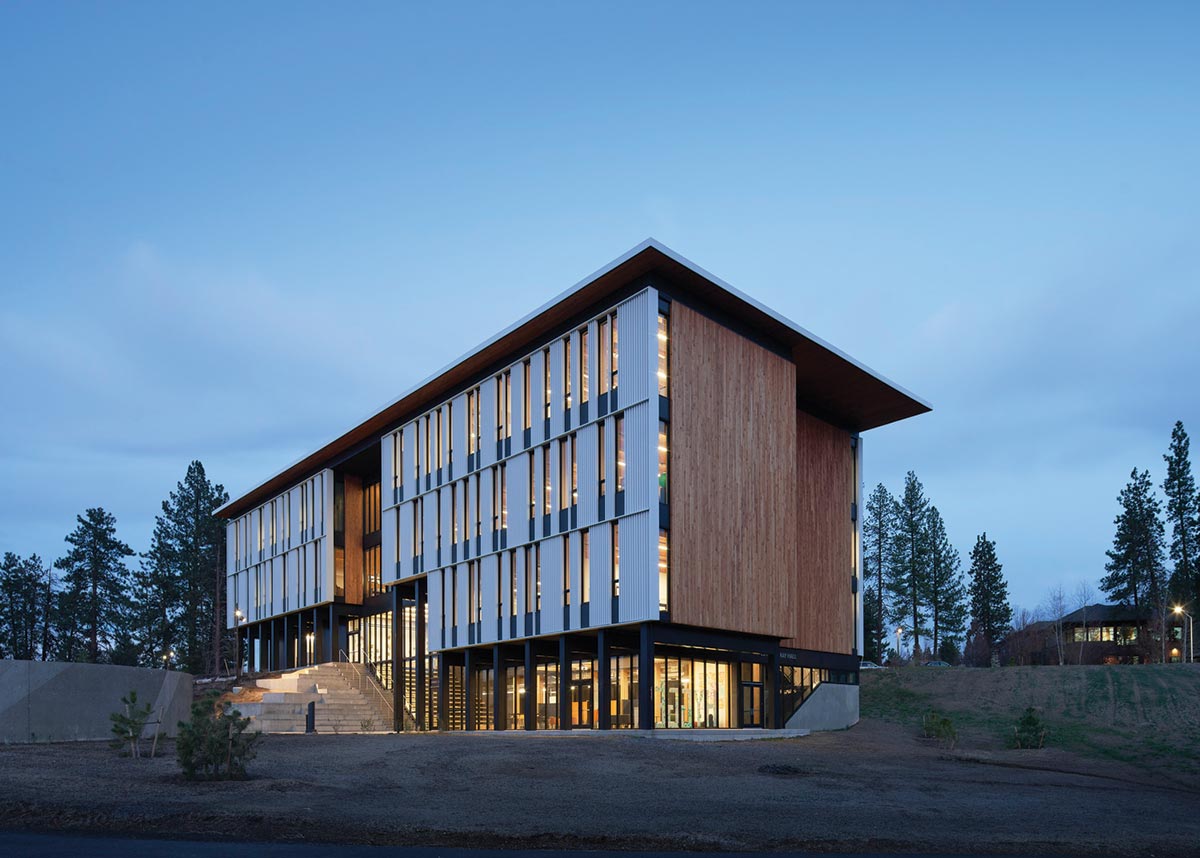
Photo © of KEVIN SCOTT
Closer column spacing at SRG’s building for the University of Oregon-Cascades saved material.
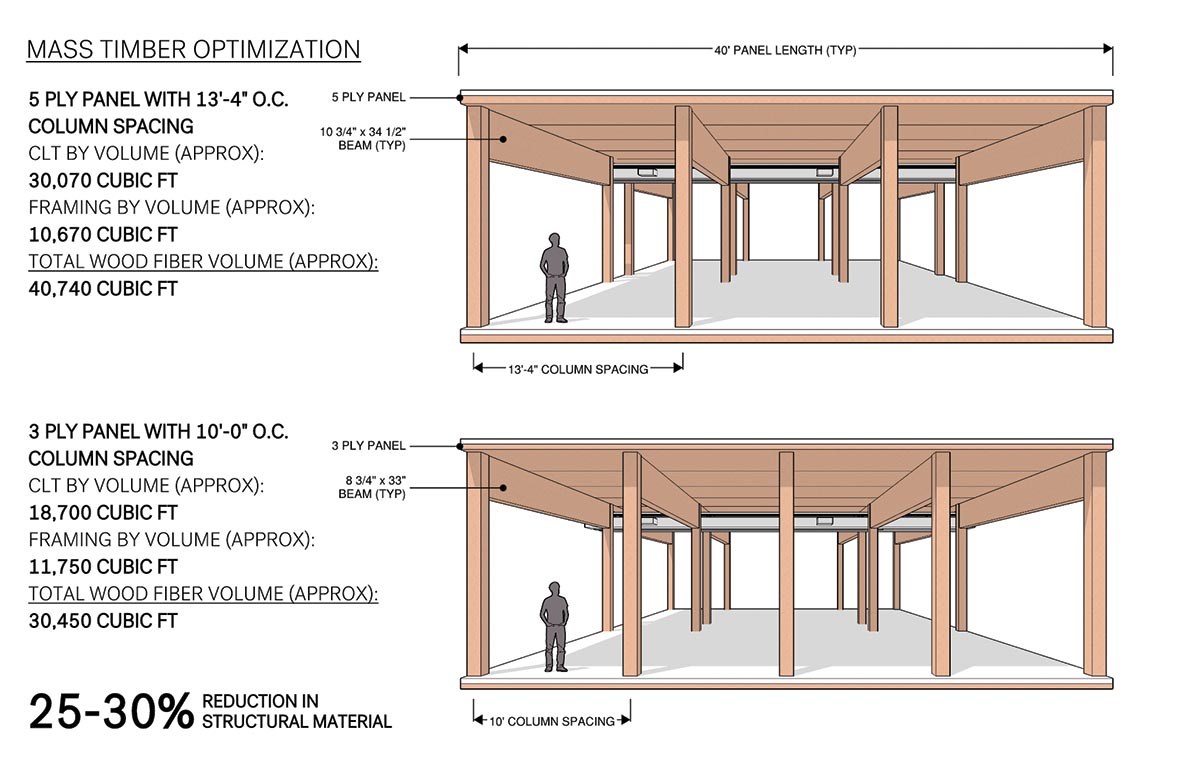
Image courtesy SRG PARTNERSHIP
Virtually all the wood products used in the terminal can be traced back to individual landowners and mills in Oregon and Washington State, or are FSC-certified. Much of the timber originated from small, family-owned forests or from Pacific Northwest tribal lands. About 370,000 board feet for the glulam elements came from the forests of the Yakama Nation, for whom the land has spiritual and cultural importance but is also a source of water, food, and revenue. The tribe’s forest-management practices include thinning from below to leave the largest and healthiest trees, generous buffers around waterways, and “no-harvest” protected areas. Such owners “have a fundamentally different relationship to the land compared to large, industrialized operations,” says Dunn.
Even when the wood comes from exemplary forests, it is still crucial that it be used thoughtfully, say timber specialists. SRG Partnership discovered just how critical the judicious use of timber can be on Edward J. Ray Hall, a $49 million, 50,000-square-foot lab and classroom building the Seattle-based architecture firm designed at Oregon State University-Cascades in Bend. Completed in 2021, the four-story mass-timber structure includes glulam columns and beams, CLT floors with concrete topping slabs, and concrete cores. Initial schemes were based on a column spacing of 13 feet 4 inches. But, through extensive analysis, it was determined that shortening this distance would result in significant materials savings. A 10-foot column spacing—which is what was eventually built—permitted CLT with fewer plies, which in turn allowed shallower beams, translating into a 25 percent reduction in wood fiber. Although the architects did not quantify the two schemes’ embodied carbon, it is logical to conclude that the closer spacing produced meaningful savings, since it also made possible a 3 percent reduction in concrete, and an overall reduction of 10 percent in building mass. Notably, it shaved $10 per square foot from the construction cost. “The analysis underscores the importance of whole-systems thinking,” says Lisa Petterson, SRG principal in charge.
Using timber wisely also includes considering what will happen to the material once the structure has reached the end of its useful life. Buildings, the experts say, should be detailed to increase the chances that components will be reused rather than discarded. At SOM’s COB3, details that will decrease the likelihood that its components will end up in landfill—where they would return their stored carbon to the atmosphere—include steel bucket connections at the base of each glulam column in the H-shaped five-story building. Their threaded rods and nuts could be unscrewed, if necessary, says Eric Long, a structural engineer and SOM partner.
Other features of COB3 were conceived to prevent its obsolescence. The building anticipates changes, with structural bays designed to accommodate a variety of open- or closed-office configurations. Precut penetrations in the building’s beams, which will in large part remain exposed, should allow for the necessary infrastructure, regardless of workspace layout, including lighting, mechanical systems, and sprinklers. “The future has been built in from day one,” says architect Francesca Oliveira, an SOM principal.
COB3’s forward-looking strategy demonstrates the relevance of design in addressing climate, and how decisions made now, starting with the forest but extending to the building’s frame, can affect the future. “The reality is, our choices have an impact,” says LEVER’s Robinson. Architects need to be cognizant of that, he says, designing for the larger materials landscape. “It is a role for architects to play.”
Project: PDX Main Terminal Expansion
Location: Portland, Oregon
Architect: ZGF
An airport terminal reaches for the sky with a spectacular mass-timber roof
BY RANDY GRAGG
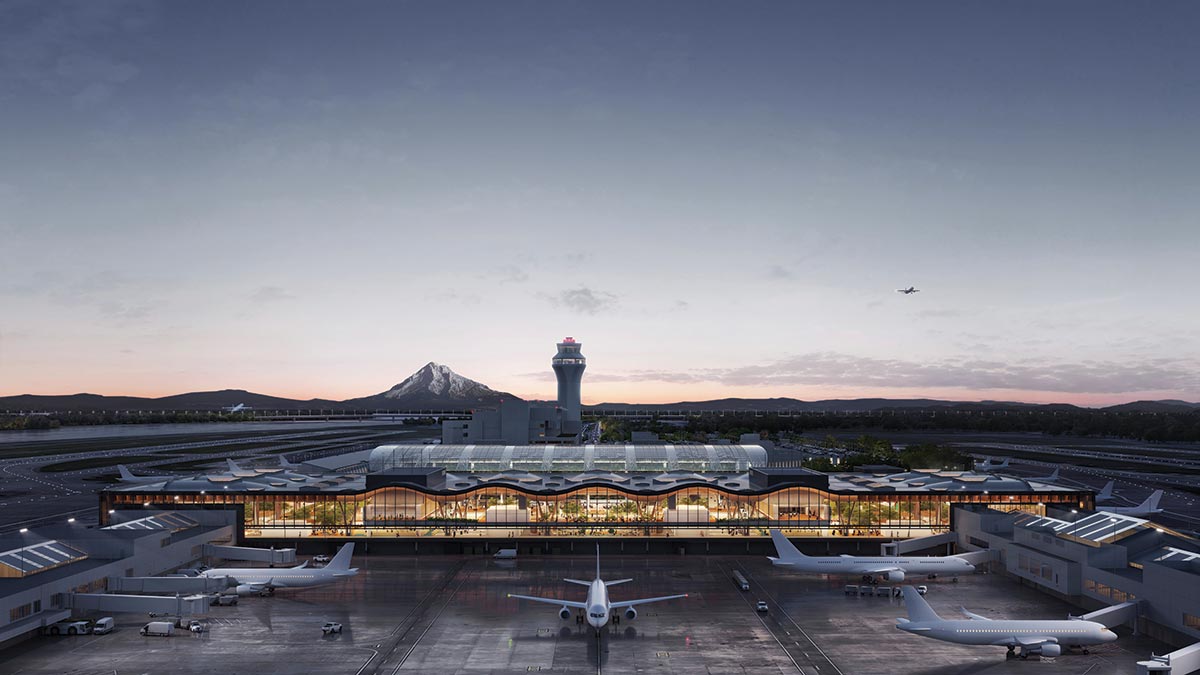
Image © PORT OF PORTLAND/ZGF
The new terminal, with its undulant roof will be twice the size of the one it replaces.
Since the Portland International Airport (PDX) first sprouted 83 years ago next to the Columbia River, its operator, the Port of Portland, has aimed to give travelers a deep sense of the local. Early versions of the main terminal framed nearby Mount Hood with a dynamic entry of western cedars planted in runway-inspired chevron rows. As explosive growth obliterated those features, the Port brought the region indoors with the “Oregon Market”—often described as the first entirely locavore airport shopping experience in the world—offering boutique Oregon wines, eats, and an outpost of the famed Powell’s Books.
Several local architectural firms have stewarded the “sense of place” that routinely nets PDX “top airport” awards, but none more than ZGF, designers of over a dozen expansions and remodels since the 1960s. The latest, a dramatic enlargement and rethinking of PDX’s main terminal, set to open next year, takes the ethos to new heights, architecturally, economically, and, perhaps, even politically.
Constructed by Hoffman Skanska, with KPFF as the structural engineer, the design is inspired by what ZGF partner Gene Sandoval describes as “your first walk in an Oregon forest.” Visitors will arrive at a nine-acre room where a grid of 34 steel columns branch 53 feet upward throu¬gh an undulating lattice “overstory” made of 34,000 lengths of 3-by-6-inch timbers. Rising and falling in a basket-weave of arches and scallops and gently filtering the sun through 46 skylights, the lattice will offer a forest canopy’s calming sense of enclosure. But in three central places, the lattice will vault upward around oval-shaped skylights, opening like a sudden clearing. The entire 400-by-1,000-foot volume will be laced with trees and hanging plants and wrapped by floor-to-ceiling curtain walls of glass, creating a biophilic refuge for watching the busily taxiing planes.
The structure, sourcing, and systems behind the space are equally impressive. The ceiling’s curves are shaped by 1,684 variously flat or arched glulam beams. The roof’s resulting ski-mogul bumps are shaped by a 2-inch-thick mass-timber diaphragm. In all, 3.3 million board feet, entirely Douglas fir, along with the milling and fabrication, were sourced within 250 miles. Doubling the old terminal in size and capacity, this single volume will serve all functions: ticketing, shopping, and airport security, but with a projected 90 percent reduction in fossil fuel use through such features as a radiant-floor system tied to a ground-source heat pump drawing from a sandstone aquifer 500 feet below and 30-foot-tall curtain walls in which the mullions have been designed as an exoskeleton to reduce heat transfer.
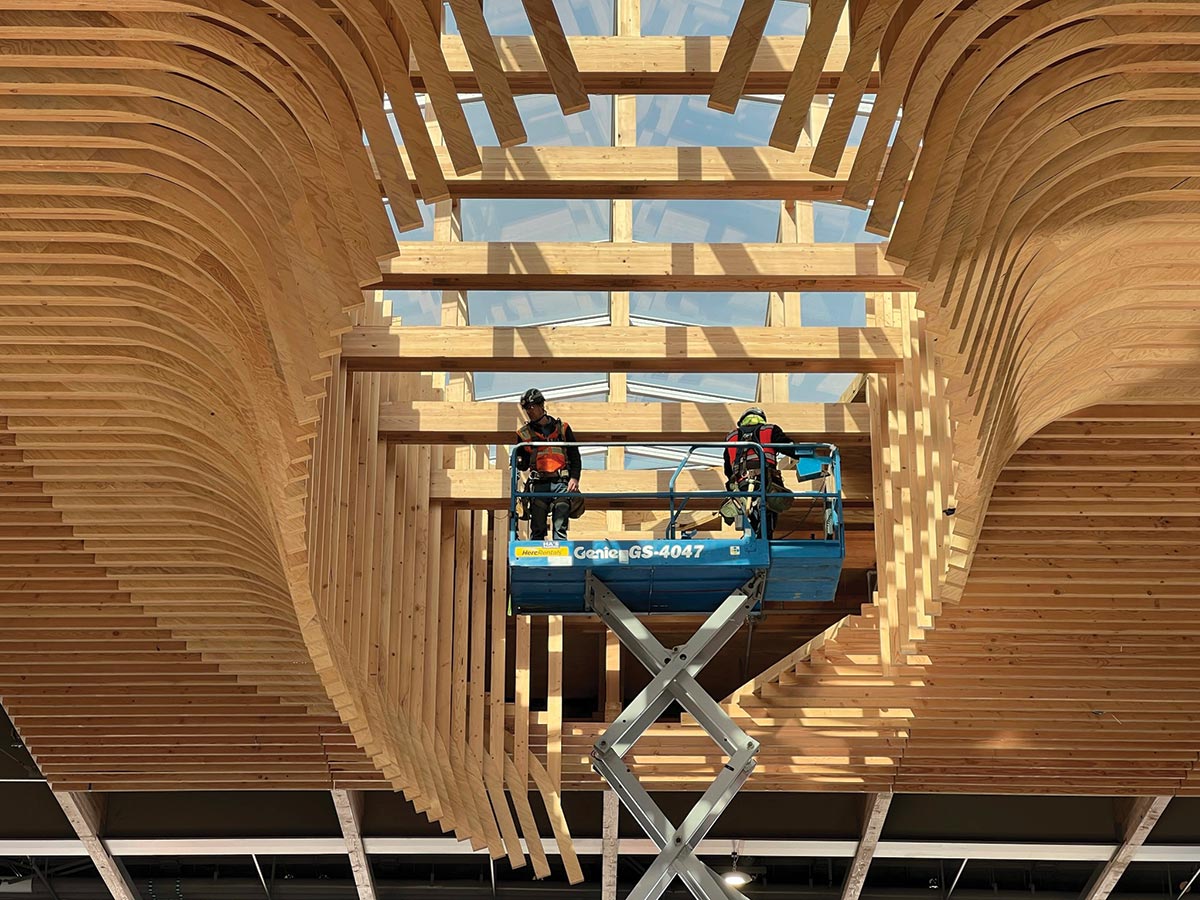
Photo © PORT OF PORTLAND/ZGF
A wood-lattice “overstory” will filter the sun from 46 skylights into the tree- and plant-filled terminal.
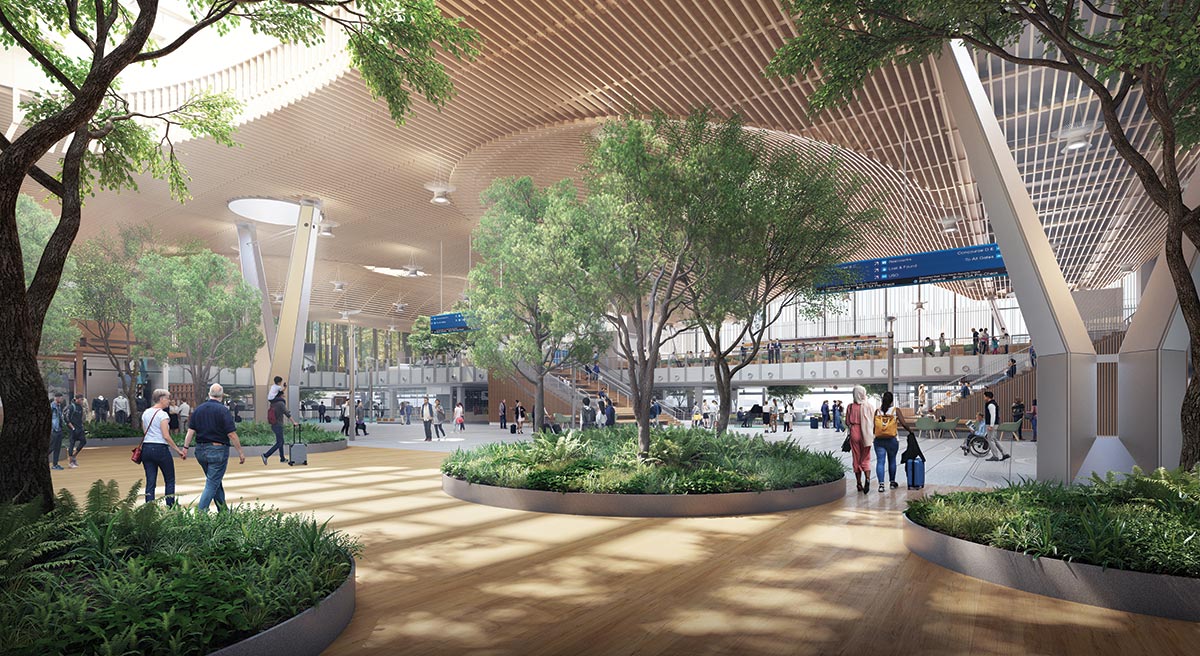
Photo © PORT OF PORTLAND/ZGF

Photo © PORT OF PORTLAND/ZGF
The terminal has been engineered so that when the inevitable 9.0 Cascadian subduction zone earthquake comes, the building will be operational within days. KPFF moved to the top of each column the cups and bearings normally used to isolate the base of a building from the shuddering ground. With the curtain walls hung from perimeter beams, the roof and walls will be able to move up to 22 inches free of the slab and columns. Beyond providing resiliency, the design allowed the steel columns to be narrowed to their thin, tree-like profile.
The stunning architecture leapfrogs a cluster of practical problems. Like virtually every major airport, PDX grew through an agglomeration of additions; the main terminal, alone, is made up of eight separate structures of different eras sitting atop 200 columns, some built of 1950s-era wood—all in the liquefaction-prone soils that filled what once was marshlands. According to Vince Granato, chief projects officer for the Port of Portland, attempting to upgrade the old structure would have triggered dozens of complex, individualized, and costly seismic upgrades. And such a terminal would lack the open spans prized by airlines, and the ability to accommodate the Transportation Security Administration’s (TSA) ever-changing ticketing and security protocols. The new facility, he says, “needed to be flexible enough to adjust to the changes in the passenger journey that we can’t even anticipate today.”
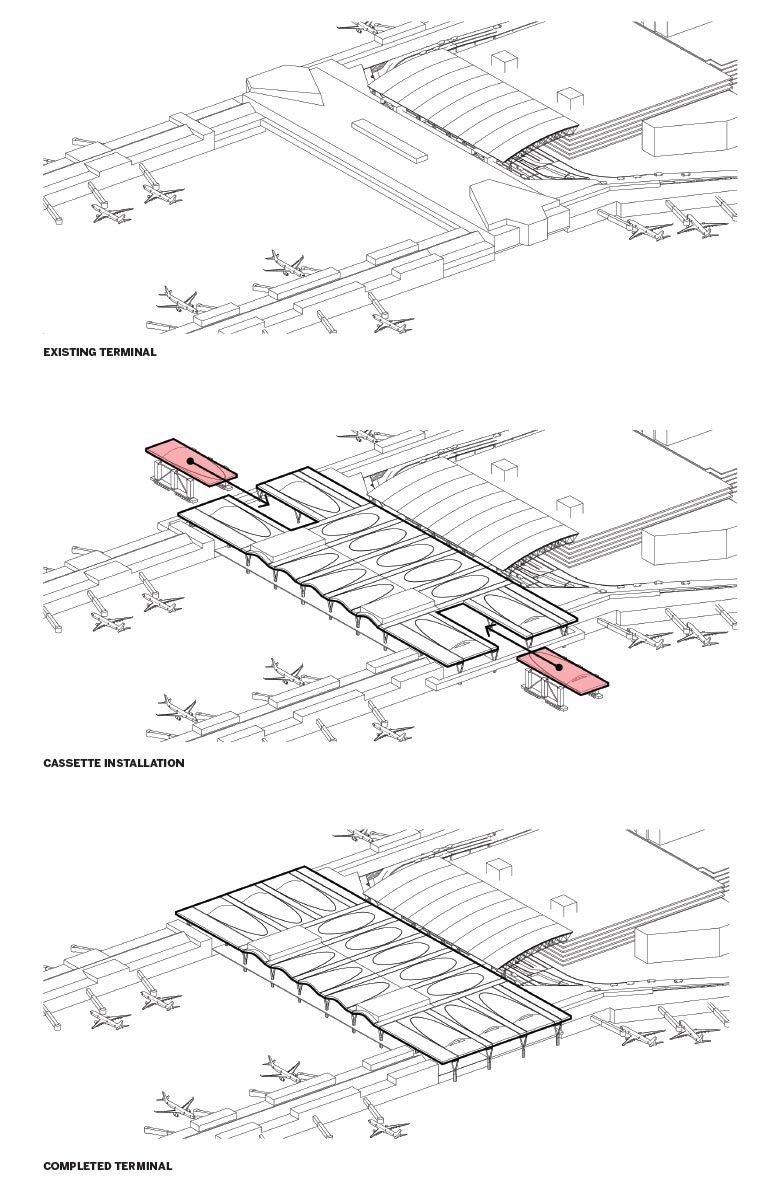
Photo © PORT OF PORTLAND/ZGF
While many airports—among them Denver, Salt Lake City, New Orleans, and Kansas City—solved similar constraints by building anew on greenfield sites, Oregon’s half-century-old agricultural-land protection laws long ago precluded building anew in the grape-rich Willamette Valley. The solution became a phased replacement on the site of the existing terminal. “This land is all we’ve got,” says Granato, “so we’ve had to get creative.”
Construction logistics were a major driver. The new facility had to be built while the old terminal remained operational. Control tower sight lines preclude cranes. Federal Aviation Administration rules forbid nighttime construction except during the four-hour early-morning no-flight window. And any work in the security zone would add measurably to labor costs, with hundreds of workers standing in TSA queues. The team’s response: monster prefab. ZGF and KPFF designed the roof to be built in its entirety—structure, insulation, and utilities—on the ground next to the existing terminal, then “unzipped” into 18 separate “cassettes,” each about 120 by 110 feet. Each piece would then be installed by giant transporters in just three nights: lift, move, and place.
The Port pushed for as much wood as possible, for its lower carbon footprint, to showcase Oregon’s forest-products heritage and continued innovation, and to make the project a regional economic driver (see story, page 138). To achieve the long spans needed for optimal ticketing and TSA security checks, the design required numerous engineering and construction innovations and, Sandoval notes, 160 local building code appeals. Eugene, Oregon’s Zip-O-Laminators, for instance, had never built 80-foot-long glulam beams before, much less ones 9-foot-3-inches deep and bent into 15-foot-6-inch arches. For longer spans, KPFF developed never-before-achieved moment connections between 6-foot-deep steel-and-wood girders. Freres Lumber, a 100-year-old family-owned Oregon company that invented its own mass-plywood panel, had to uniquely shape 1,350 panels, most 11 by 30 feet, many with parabolic curves, to create the undulating roof. The lattice’s basket-like twists and turns required individual puzzle-piece-like cuts, a daunting amount of finish carpentry. ZGF broke the elements down into seven profiles that could be factory fabricated and bar-code labeled to facilitate quick assembly.
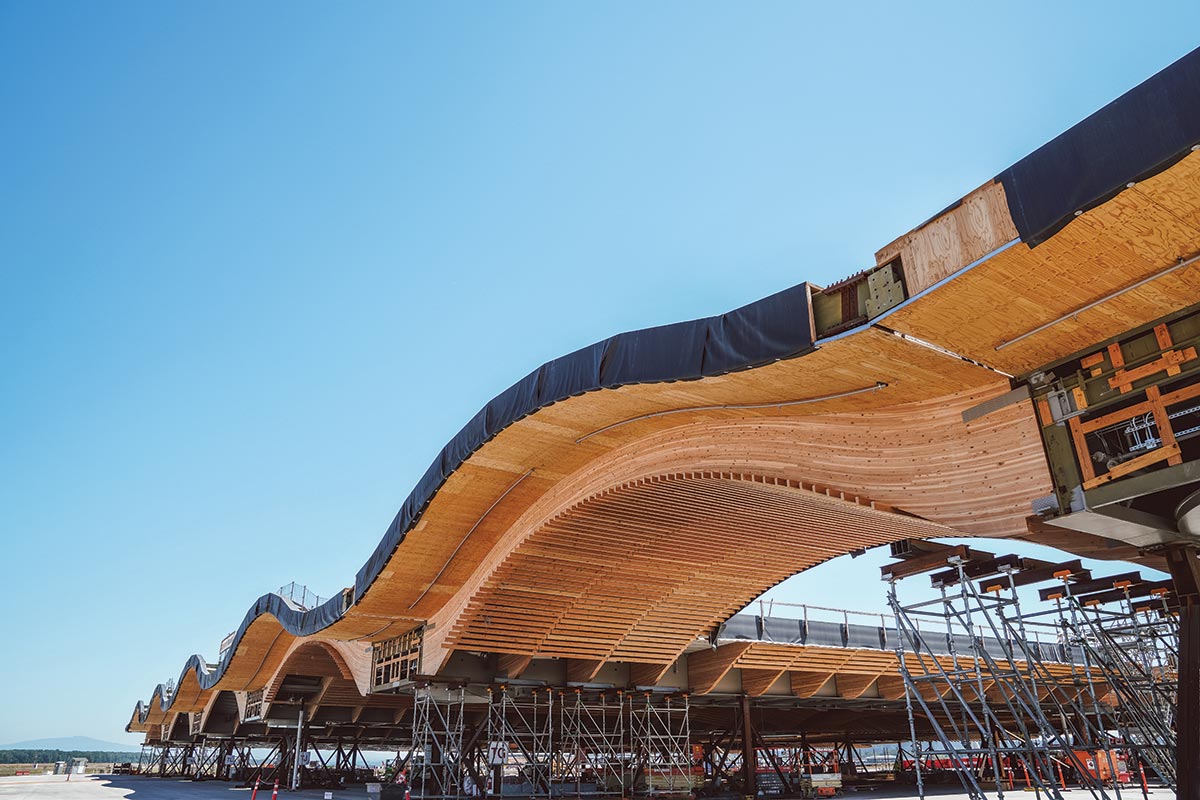
Photo © TIMBERLAB/FLOR PROJECTS
The roof was built in its entirety next to the existing terminal and then installed as “cassettes,” or modules, at night.

Photo © TIMBERLAB/FLOR PROJECTS
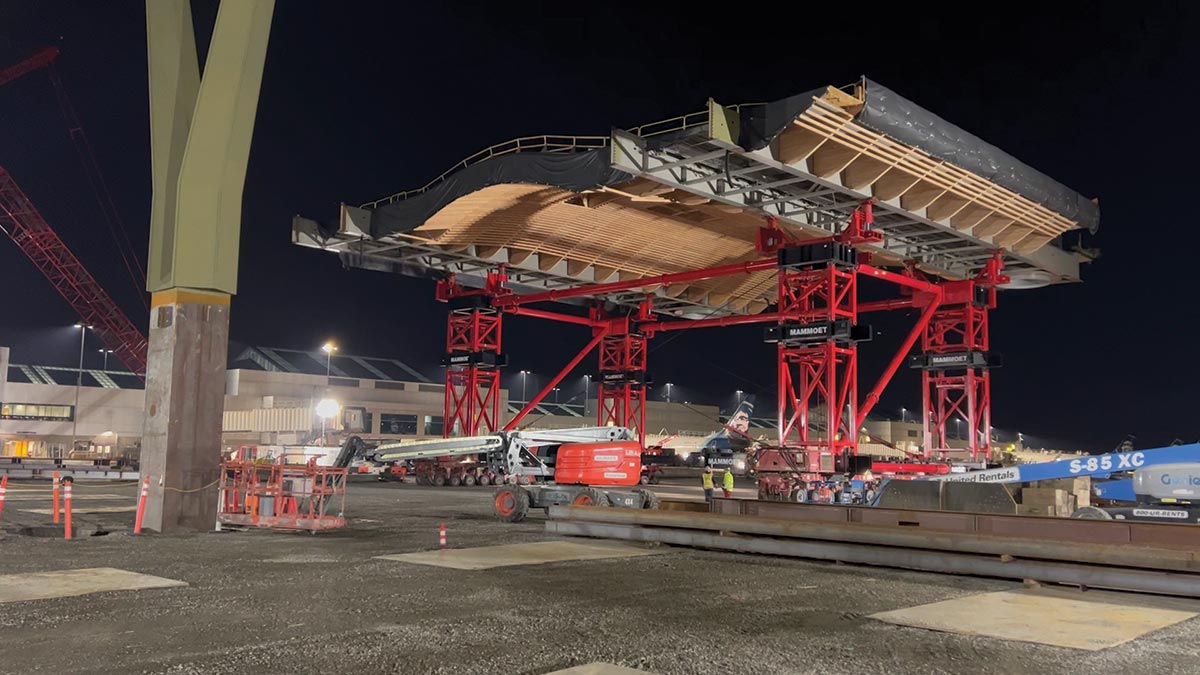
Photo © PORT OF PORTLAND/ZGF
On a March walk-through, 14 of the cassettes were in place. Ten-thousand-pound weights dangled from the perimeter beams, preloading them for the eventual hanging of the curtain walls. But even at 50 percent completion, the overall effect was thrilling, the still-unwoven sections of lattice revealing the many layers of cutting-edge wood structures above.
Sandoval describes the terminal as “maybe the most tectonically pure building we’ve ever done” and contends that the methods pioneered at PDX might solve similar problems faced by the world’s growing number of landlocked airports. But, more locally, he says the team also hopes the Oregon-crafted main terminal can be a stitch between the urban/rural divide, referring to the often politically contentious relationship between major Northwest cities and their surrounding resource-based small towns. “Maybe we can bring everybody together with a building made by many, from scientists to architects and engineers and people who just like working with their hands.”
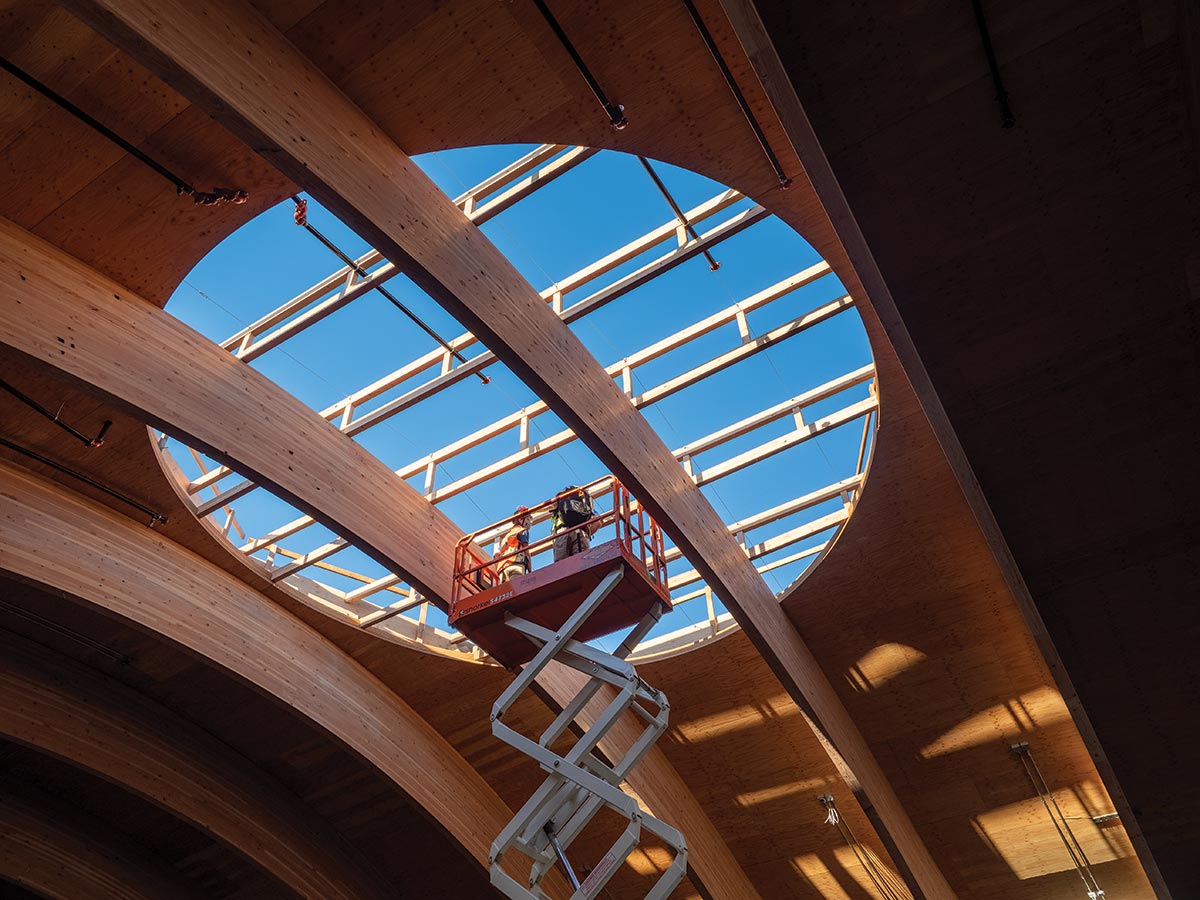
Photo © MIKE BREWINGTON
The arched beams are up to 80 feet long. The in-progress installation of the lattice reveals the many wood layers above.

Photo © Freres
Credits
Architect: ZGF Architects
Engineers: KPFF Consulting Engineers (structural); PAE (m/e/p)
Consultants: Swinerton (mass-timber trade partner); W&W AFCO Steel (steel trade partner); Sustainable Northwest, Sustainable Northwest Wood (wood advisors); Arup (aviation planning); Terrapin Bright Green (sustainability)
General Contractor: Hoffman Skanska Joint Venture
client: Port of Portland
Size: 1 million square feet
Cost: $1.79 billion
Completion date: 2025
Sources
Exterior cladding: Morin (metal panels); Henry (moisture barrier); Benson Industries, Arcadia (curtain wall); McKinstry (exterior sunshades)
Mass Timber: Timberlab, Calvert, Freres, Zip-O-Laminators
GLulam connections: Madlyn Metals Fab
Y Columns: Thompson Metal Fab
Skylights: Deamor
Glazing: Carey Glass, Glas Trösch, Viracon
Paints amd stains: Timber Pro
Seismic Isolators: Maurer
Starts and Stumbles: The Rocky Road to Europe’s Ambitious Timber Construction Targets
BY KATHARINE LOGAN
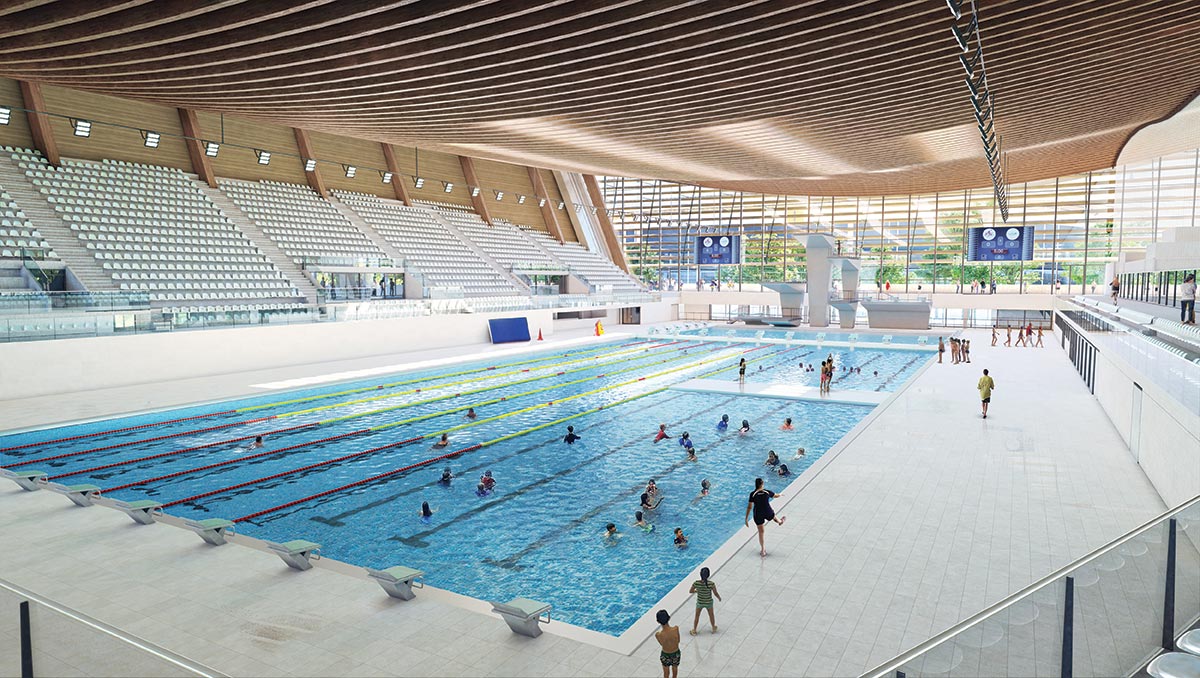
Image © PROLOG
The aquatics complex by VenhoevenCS and Ateliers 2/3/4, for the 2024 Olympics in Paris, will have a vast timber roof.
Europe is a clear leader in mass-timber construction—home to 60 of the world’s 84 tall timber structures (eight-plus stories), according to a 2022 count by the Council on Tall Buildings and Urban Habitat—and there’s no shortage of ambition to scale up. With an eye to the material’s renewable and carbon-storing properties and its fit with prefabrication and circular economies, European jurisdictions have introduced a slew of initiatives to increase building with wood. But, while these measures are important steps, in practice major obstacles remain.
Policies and programs introduced to date are widespread and wide-ranging. In the Netherlands, 32 municipalities and over 80 companies and agencies in the Metropolitan Region of Amsterdam (MRA) have signed a Timber Construction Covenant, agreeing to use wood as the primary structural material for at least 20 percent of residential buildings by 2025. In Finland, targets for the use of wood in public construction aim to reach 45 percent of market share by 2025. In France, public buildings, including those constructed for the 2024 Paris Olympics, are mandated to use bio-based materials. The requirements are set at 25 percent of major refurbishments and new construction by 2025, increasing to 50 percent by 2030. France also mandates life cycle embodied-carbon analysis for residential buildings, schools, and select commercial-building types, with limits set to tighten in stages. In Sweden, life cycle embodied-carbon calculations are a precondition for planning permission for new buildings, with limits on embodied carbon likely by 2027. At a supranational scale, the European Commission is considering an EU-wide requirement to measure construction materials’ life cycle carbon emissions; also contemplated is a provision for EU member states to create national building-renovation plans setting out how they will reduce embodied carbon.
So far, though—apart from small-scale residential projects, which are not going to densify cities using bio-based materials at scale—progress is still a series of starts and stumbles. “There’s a lot of timber plans, but not nearly as many timber-construction sites,” says Mathew Vola, director of sustainable development in the Amsterdam office of Arup. The office provided a range of engineering services to two recent local timber developments: HAUT, a 21-story residential building (with concrete foundation, basement, and core) designed by Team V Architecture and completed in 2022; and Mediavaert, DPG Media’s 495,000-square-foot headquarters (also by Team V), now under construction and set to become Europe’s largest timber-hybrid office building. But even with the MRA’s pro-wood covenant, Vola can count on one hand the number of large-scale timber projects that are actually going up in the Netherlands. “Everyone wants to do timber, but somewhere along the line the ambition gets lost,” he says. “In our experience, it always has to do with the business case.”
While the specific obstacles that burden timber’s business case vary from jurisdiction to jurisdiction, from his experience in the Dutch context, Vola identifies three general sticking points. The first is a lack of financial incentives for making the switch from concrete and steel. For example, in the Netherlands, the cement and steel industries are both exempt from carbon tax: “You could argue that this exemption amounts to a subsidy for those industries,” Vola says.

Photo © JANNES LINDERS
HAUT, a 21-story residential building in Amsterdam, is one of relatively few large-scale timber projects in the Netherlands.
It’s difficult to make headway against concrete’s advantages in Finland too, according to Mikko Leino, CEO of Helsinki-based mass-timber fabricator and builder Puurakentajat Group: “Big construction companies often have links to, or ownership of, concrete and cement integrated into their balance sheets,” he said in a recent webinar hosted by the Swedish office of the Programme for the Endorsement of Forest Certification (PEFC). Without incentives, “it takes a long time to turn that ship.”
In the UK, the advantaged competitor is a bit different: there are greater incentives to burn wood than there are to build with it, says Andrew Waugh, founding director of London-based Waugh Thistleton Architects. “The use of wood for construction is taxed and unsubsidized, whereas its use for fuel is subsidized and untaxed. Most of the trees that are cut in the UK are burned.”
The second burden on timber’s business case is supply bottlenecks. The European cross-laminated timber (CLT) market reached 1.6 million cubic meters in 2022, and is expected to reach 2.9 million by 2028, according to a report by the International Market Analysis Research and Consulting (IMARC) Group. But, for the moment, says Vola, demand exceeds supply. Counter-intuitively, the solution may lie in further increasing demand. A 2021 policy-gap analysis of programs promoting timber construction in Norway, Sweden, and Finland found a widespread expectation among sector experts that increasing demand for timber components will stimulate competition in the market and help smooth out supply-chain inefficiencies and shortfalls. In Amsterdam, says Vola, “one of the things the MRA is trying to achieve is a more constant demand for these factories to run.”
The third constriction is a shortage of education among industry players. “You can design timber buildings that are just as safe, just as water-resistant, just as acoustically friendly as concrete buildings—better, even,” says Vola, “but we don’t have enough timber knowledge widespread in the industry to deliver them.” Because of wood’s low weight and sensitivity to moisture, light, and fire, it’s more dependent on careful detailing and construction practices than are concrete or steel. “In a first generation of fairly poorly designed timber buildings, you see quite a number of damage cases,” says Vola. Insurers see them as well. “That’s perceived as risk. Risk translates to added cost.”
Closely related to the need for education is a need for standardized solutions. Technical issues are being resolved project by project, says Lars Tellnes, one of the authors of the Scandinavian policy-gap analysis, but “codes are developed on standards.” This ad hockery feeds the development of diverse and, in some cases, unnecessarily stringent, regulations, which translate into project costs and sector uncertainty. “Apparently, wood burns differently in Turku from how it burns in Helsinki,” Leino says wryly. He describes uneven regulations and, especially, uneven interpretation of them as “a huge attitude issue.”
In England, the attitude issue is compounded by the legacy of the fatal 2017 fire at the Grenfell Tower, a 24-story concrete structure with combustible envelope components. New regulations in response to the tragedy ban combustible materials in external walls of residential buildings over six stories. The inclusion of mass timber among the banned materials has changed the perception of industry members, insurers, and to some degree the public “to a ‘Three Little Pigs’ mentality,” says Waugh, which he describes as an obstacle to timber construction: “In the rest of the world, codes are changing to promote mass timber’s use. That’s just not happening in the UK.”

Photo © JAKE CURTIS
Waugh Thistleton Architects, designer of a six-story mass-timber office building in London, is collaborating on efforts to create prewarrantied wood-construction details for both the residential and construction sectors.
To help the European timber-construction sector through these growing pains, a number of new initiatives are under way. In a project funded by Built By Nature, a philanthropic organization, Waugh Thistleton is
collaborating with University College London and Buro Happold to build confidence in timber construction among UK insurers, code officials, contractors, and clients. Focusing on residential construction up to six stories high, the team is developing a pre-warrantied system of 25 building details along with a suite of specification guides covering fire safety, water management, and construction practice. The resource, to be made available as an open-source document, “will ensure that mass-timber residential buildings can be built to competent standards and will be insurable and able to obtain mortgages,” says Waugh, “hopefully kick-starting low-carbon timber development across the UK.” In another Built By Nature–funded initiative, Waugh Thistleton is collaborating with a diverse consortium, led by engineering consultancy Elliott Wood, to design similar systems for the commercial office sector. These will be made available internationally, including in the United States.
Under the auspices of Build-in-Wood, an EU-funded program based at the Danish Technological Institute, seven cities from across Europe, representing a range of sizes—capitals Amsterdam and Copenhagen, a borough of London, two mid-size cities (Trondheim, Norway, and Brasov, Romania), and two smaller ones (Innsbruck, Austria, and Trento, Italy)—have identified focus areas for boosting timber construction in their jurisdictions. Priorities include strengthening local wood value chains, enhancing training and regional knowledge, and facilitating cooperation between industry and municipal administration. Additional goals include simplifying building codes and promoting timber-positive public-sector procurement. Some of the participants emphasize urban densification through adding new stories onto existing buildings, and facilitating circular economies for wood construction. Build-in-Wood is supporting these seven cities through a program of detailed context analyses, workshops, and implementation guidance. A publicly available policy catalogue, developed in partnership with Bucharest-based planners Urbasofia, presents and analyzes policies and best practices for prioritizing wood in multistory buildings, and will eventually incorporate results from the early-adopter cities. Build-in-Wood has also established an international knowledge-sharing network, with 1,300 members and growing.
Meanwhile, as companies’ success increasingly links to environmental, social, and governance (ESG) factors, private-sector investors are seeing the value of wood in a new light, says Vola, one in which the material’s additional costs bring in additional benefits. “Looking to the future, a carbon-friendly timber building is more interesting to investors than a polluting, non-circular concrete one,” he says. “The hope is that, as this goes through, it does put a more positive spin on the value of timber construction. The business case does make sense.”
Rising from the Ashes: Mass Timber Helps Resurrect Fire-Torn Greenville, California
By SARAH AMELAR

Image © ATELIERJONES
Weathering-steel cladding provides extra fire protection.
The Dixie wildfire—one of the largest in California history—began in July 2021, blazing through nearly a million acres of forest and, in the rural town of Greenville alone, destroying nearly 600 homes and most of the village center. While residents were still reeling from the devastation, Steve Marshall, an expert on mass timber, and Jonathan Kusel, executive director of the Sierra Institute, a local nonprofit focused on community revitalization and the environment, came up with an idea: what if the institute facilitated the use of cross-laminated timber (CLT), an engineered-wood product, to fast-track the creation of high-quality, fire-hardened replacement homes in Greenville—demonstrating the material’s potential while permanently rehousing people and boosting the local economy? Marshall—a 42-year veteran of the U.S. Forest Service—had just been working with Kusel and others on a Sierra Institute report for the State of California with recommendations for future uses and possible manufacture of mass timber, including CLT—a material that took off in Europe in the 1990s, but is relatively recent in the U.S. Its panels—engineered from kiln-dried lumber, layered with the grain in alternating perpendicular directions and pressure-bonded with adhesives—can produce buildings that are lighter in weight and more carbon efficient than those of concrete or steel, yet structurally strong, seismically resilient, and fire resistant. When exposed to flames, CLT’s outer layer forms a seal-like char, which protects the dense, unburnt core from damage or even significant temperature rise. Since the panels—which perform well for roofs, floors, and structural shells—are typically factory precut, the work on-site (once land preparation and foundations are done) is more assemblage than traditional construction. Doubling as a structural system and basic enclosure, CLT tends to require smaller crews and less site time than, for example, stick framing. Soon after discussing ideas for rebuilding, Marshall made a match between the Sierra Institute and the Seattle-based architectural firm atelierjones, one of the few practices with extensive experience designing houses primarily with CLT. Its founding principal, Susan Jones, had not merely used it for houses, including her own—but also, between 2016 and 2019, had helped develop the International Building Code for mass-timber buildings up to 18-stories tall. Her projects with such materials have ranged from religious structures to multifamily high-rises. Meanwhile, the Sierra Institute also had experience with mass timber, having used it in 2018 to construct a modest biomass-fueled power plant, California’s first almost entirely CLT building. But this would be the organization’s initial foray into CLT in the residential realm. “The majority of Greenville’s pre-fire population, of just under 1,200, had lost their homes—it was disastrous,” recalls Kusel. “Even though we couldn’t rebuild everything instantly, we could give the community hope, confidence, and a path forward by demonstrating and offering ways of creating well-designed houses quickly—and with dramatically improved fire-hardening.” Fortunately, atelierjones had a head start, having already produced modular houses elsewhere, with designs it could adapt or borrow from. In 2022, the Sierra Institute commissioned the firm to produce three prototypical schemes—for one-, two-, and three-bedroom houses—with some add-on and accessory dwelling unit options for future growth. The organization then offered the designs free of charge to residents of Plumas County, where Greenville is located and the Dixie Fire had been particularly destructive. Further expediting the process, the plans were pre-permitted—leaving homeowners simply to complete their own permitting to cover site-specific matters and deviations from the master plans. To speed construction, the initial houses will have prefabricated kitchen-bathroom wet cores, although other methods will be tried in later iterations.

Image © ATELIERJONES
The modular wet cores were craned into place, and the structural shells’ flat-packed precut CLT panels were assembled on-site.
The total construction cost (expected to range from $250,000 to $400,000, depending on house type/size) was tailored to fit within anticipated available funds. About 56 residents from this median-low-income community agreed to immediate presettlement payouts from Pacific Gas & Electric (PG&E), the utility company that took responsibility for sparking the Dixie Fire with its outdated power lines, while other homeowners are still hashing out more individualized PG&E settlements. To keep within the expected budgets, Jones designed houses—at 600, 700, and 960 square feet each—that are smaller than many pre-fire versions, but with great versatility and such architectural features as double-height living spaces, in addition to the enhanced resiliency and durability. Although CLT, at this stage in its U.S. production, can still be more expensive than “legacy” materials such as concrete and sometimes even steel, the savings come in the construction efficiencies and, environmentally, in captured carbon. Furthermore, CLT walls, exposed on the interior, eliminate any need for additional finishes, while offering the warmth, beauty (and, early on, the fragrance) of fresh-hewn wood. But for extra fire and moisture protection, as well as perceptual reassurance, in an area vulnerable to both wildfires and heavy winter snowfalls, these houses will be clad in weathering steel. The buildings will meet the strictest state codes for fire-hazard-severity zones, as well as stringent new Wildlands Urban Interface guidelines. In an ideal recovery scenario, the CLT would be manufactured nearby, using wood from the surrounding fire-ravaged forests, as it’s well established that burnt, still-standing trees are often salvageable for lumber for a significant period after wildfires. How long depends on such factors as tree size and species, weather, climate or microclimate, and the characteristics of the fire itself. Large-diameter trunks typically emerge with only the outer layer charred (like CLT), leaving the underlying wood unharmed. Though some trees, under exceptional conditions, have been salvageable longer, generally, the average time before rot sets in is about two years. A phoenix rising from ashes via locally sourced CLT would clearly be optimal for Greenville—but it’s not entirely feasible immediately. “We’re making strides in that direction,” says Marshall, noting that the whole rebuilding process could take years, allowing it to benefit from interim measures as well as later achievements.

Photo © TY O’NEIL/SOPA IMAGES/SIPA USA/NEWSCOM
Some scorched trees are chipped; others are salvageable for lumber.
One of the biggest challenges is manufacturing CLT locally. Even though California, according to Marshall, now builds with mass timber more than any other state, it doesn’t yet produce the materials itself. And, given the Greenville area’s modest population and remoteness from interstate highways, only a small CLT plant—one of the first of that size in the United States—would make sense. The Sierra Institute is working toward creating such a facility here, but the funding is not yet in place, and there are both technical and economic hurdles in scaling down.
With the clock ticking on Dixie-charred trees, the Sierra Institute has come up with alternative uses. It has already retooled and revived a long-dormant mill site, just outside Greenville, which is now churning out 2-by-4s and 2-by-6s, mostly of Ponderosa pine, the predominant species here, for sale across the region. Previously, California’s Department of Transportation (Caltrans), whose oversight includes highways, was removing and then chipping massive burnt trees that were at risk of falling onto roads bordering the woodland. The Sierra Institute successfully petitioned to have those enormous logs (some upward of 3 feet in diameter) rerouted to the refurbished mill.
“The big-picture, long-term goal,” says Jones, “is to support a small-scale local industry that would produce CLT for future home construction, here and in neighboring communities.” There’s already been significant interest from surrounding areas. And even after the scorched trees are no longer usable, the forests here, which include private and federal lands, will still require enough ongoing fire-protection maintenance, including thinning, to continue feeding local mills and CLT production. Although pine is not yet certified for such mass timber, groups elsewhere in the U.S. are progressing on that front.
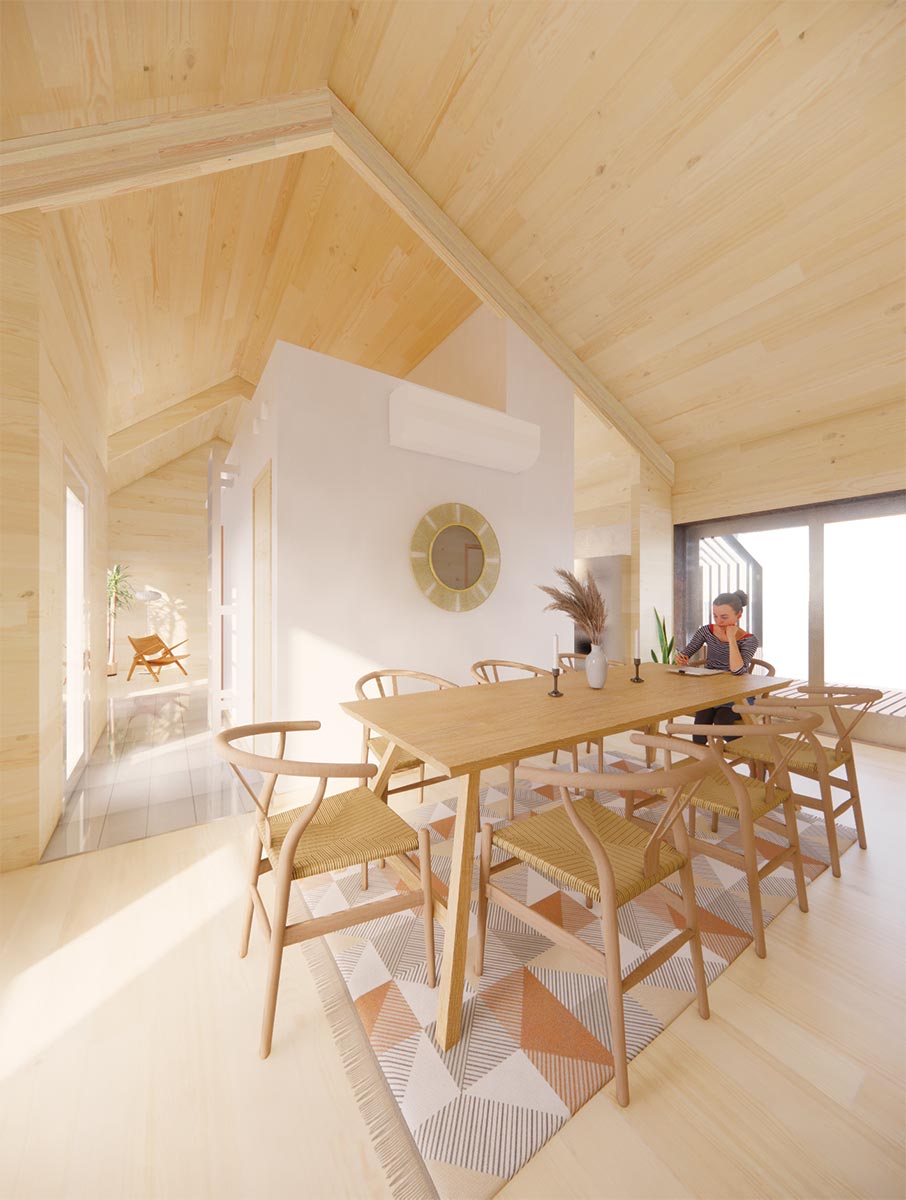
Image © ATELIERJONES
The CLT structural shell doubles as exposed interior wood surfaces.
For now, the rebuild will rely on Oregon-manufactured Douglas-fir CLT for the houses, as well as a new community center, at the heart of Greenville, for the local Maidu Indian tribe. That atelierjones-designed structure will rise on the site where the Dixie Fire destroyed a building full of irreplaceable tribal artifacts. Construction will begin this summer, with completion expected in the fall. Meanwhile, the first three houses—each commissioned by an individual homeowner—are almost done. “Response to the designs has been very positive—and we expect more commissions once more settlements are reached,” says Kusel. Among those who’ve already taken the leap, longtime Greenville resident and developer Ken Donell is not merely gearing up to move into his own new CLT house—he’s also planning to build more of them, plus a low-rise multi-family building by atelierjones, as affordable rental properties. “CLT is amazing in so many respects,” says Donell. “On top of that, its warm wood surfaces and remarkable properties are particularly well suited to Greenville, where we’re surrounded by magnificent forests—but also, of course, the potential for wildfire.”
Credits
Architect: atelierjones — Susan Jones, Meghan Doring, Eleanor Lewis, Lenore Wan, project team
Engineers: Hariott Valentine Engineers (structural); Sugarpine Engineering (m/e/p)
Consultant: Method Homes (modular wet-core fabricator)
General Contractor: Lights Creek Construction
Client: Sierra Institute for Community and Environment
Size: 600–960 square feet per house
Cost: $400 per square foot, estimated
Completion date: Late spring 2023 (first three houses)
Sources
Mass Timber: DR Johnson Wood Innovations (CLT and glulam)
Windows: Alpen
Interior paints/Stains: Sansin; Bellingham Professional Finishes
Insulation: Rockwool
Tile: Florida Tile
Project: World of Volvo
Location: Gothenburg, Sweden
Architect: Henning Larsen
The carmaker gears up to showcase its brand with a sculptural “experience center”
BY JAMES GAUER
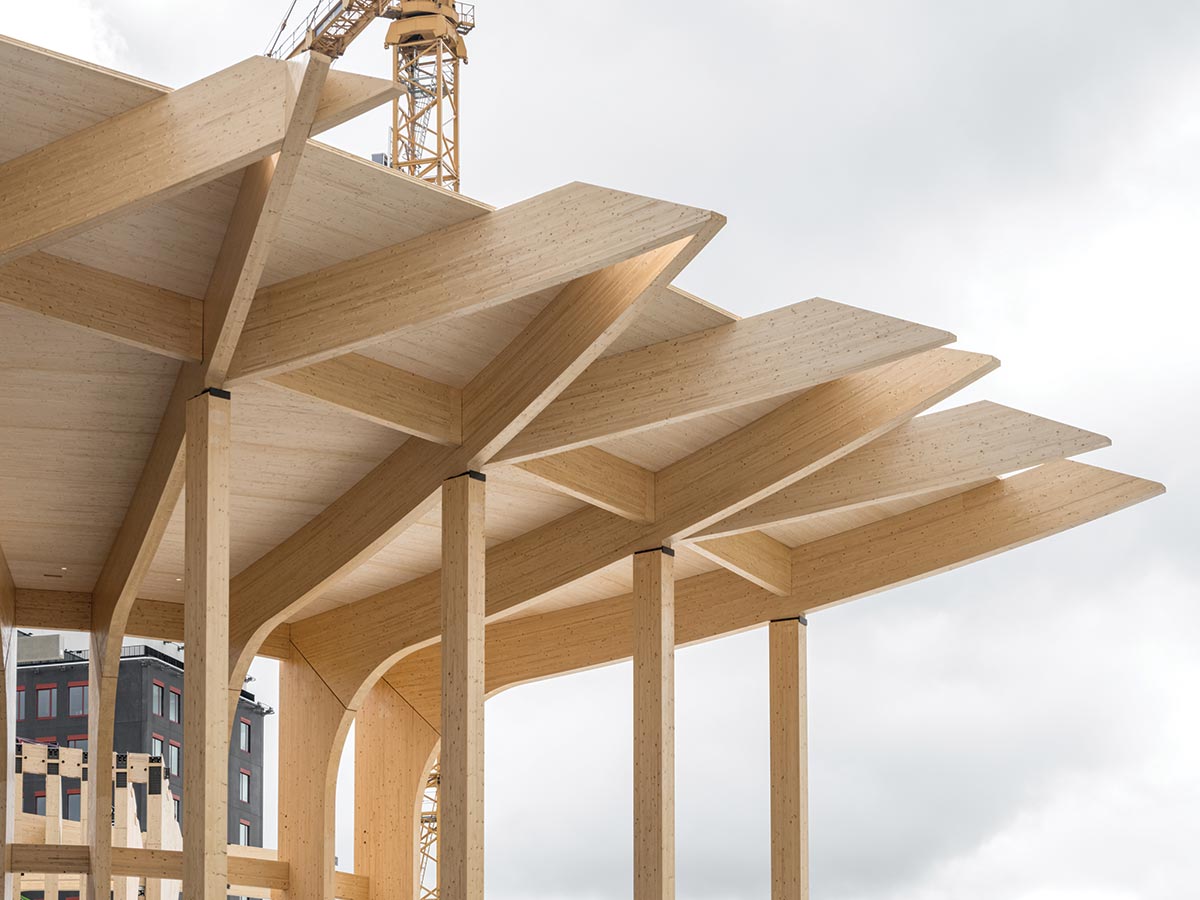
Photo © RASMUS HJORTSHØJ
Splayed mass-timber ribs structure the circular exhibition center.
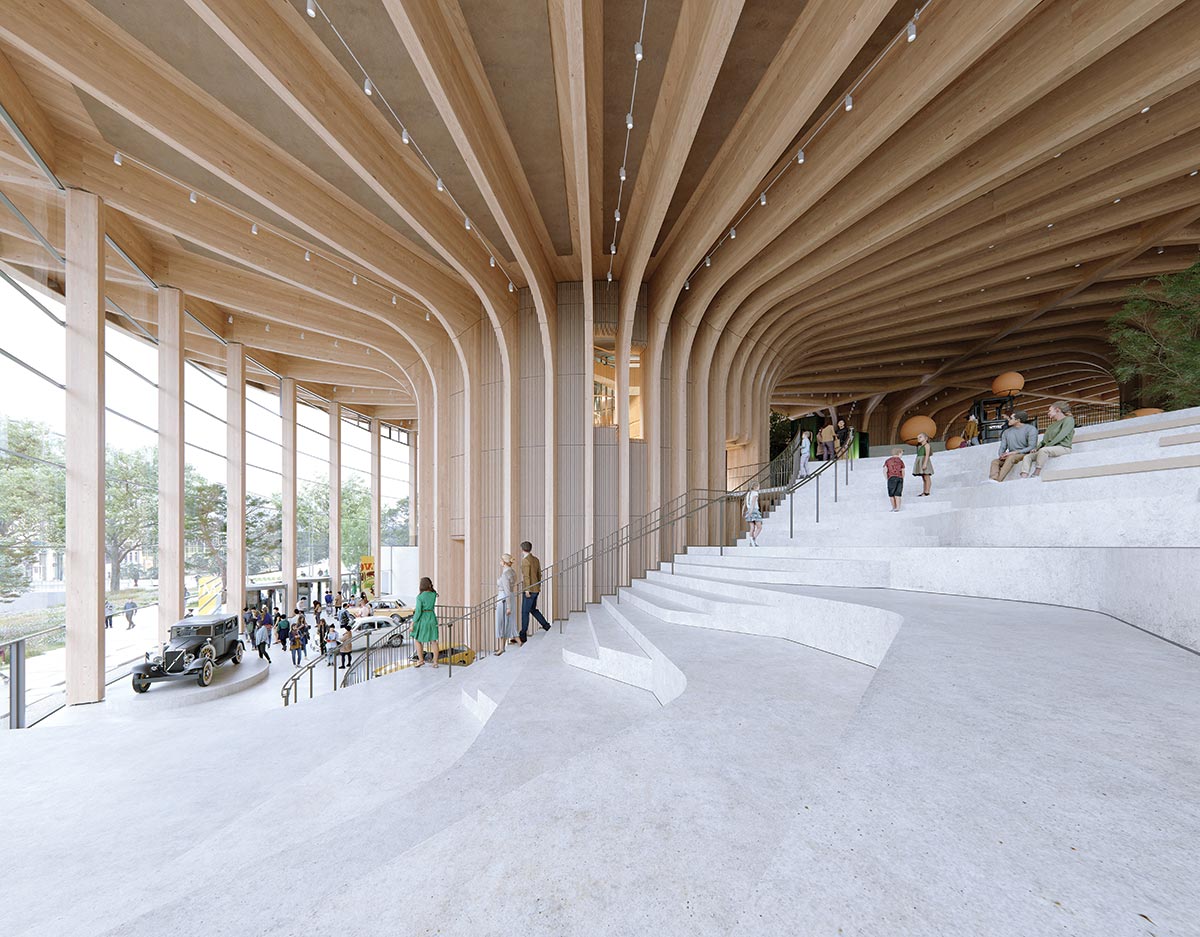
Image © KVANT
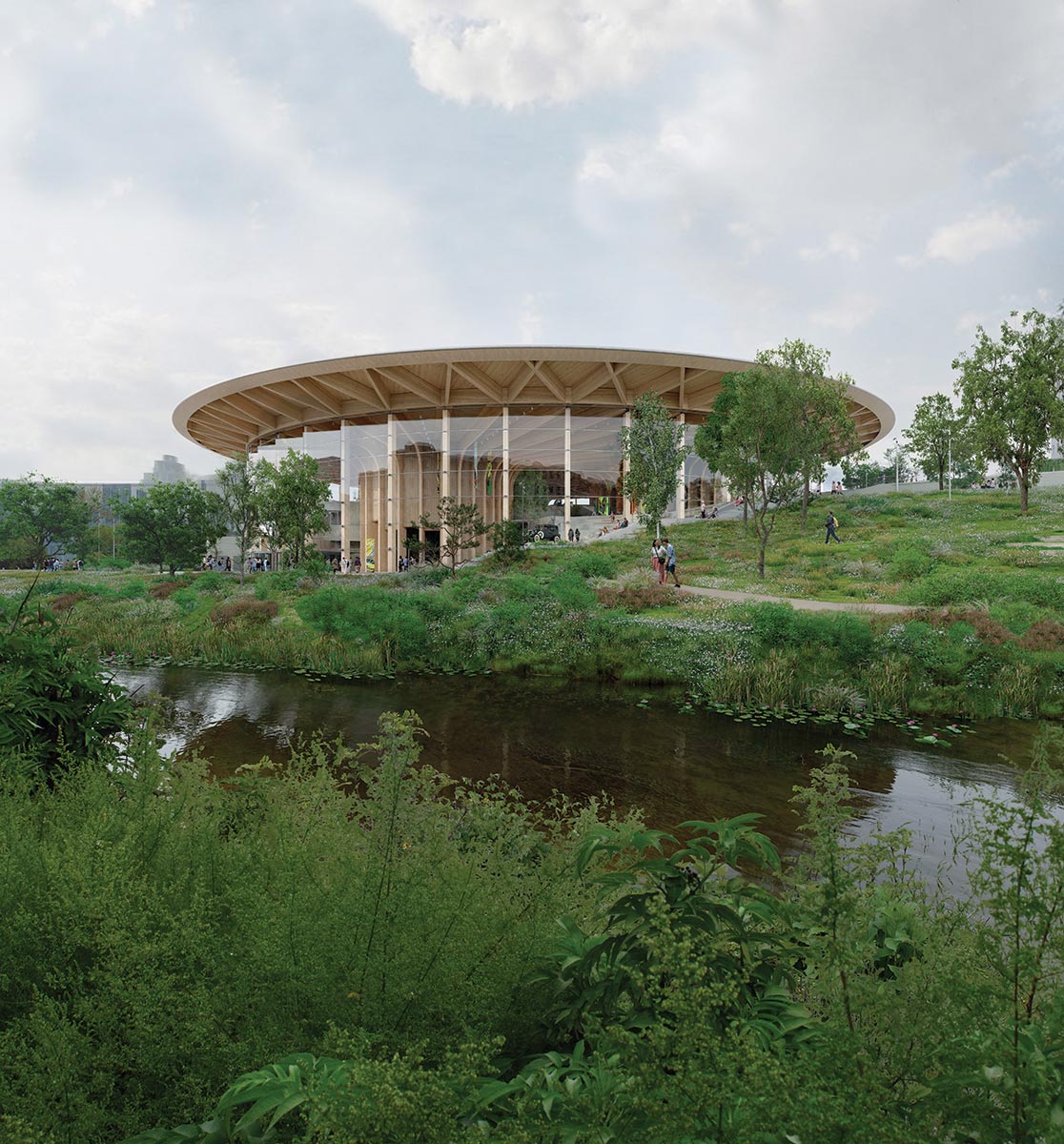
Image © KVANT
Wood is ubiquitous in the architectural heritage of Scandinavia, whose forests have long supplied an abundance of the building material. “It dates back to the Viking era and has remained an important aspect of Swedish architecture ever since,” says Martin Stenberg Ringnér, associate design director of Henning Larsen. Based in Copenhagen, the firm has designed World of Volvo, an “experience center” combining entertainment, exhibitions, food and drink, and retail in a single structure, now under construction and due to open to visitors in 2024. For this 236,000-square-foot project, located in the Swedish city of Gothenburg (which bills itself as “the world’s most sustainable destination”), timber takes center stage.
Situated in Gothenburg’s event district, home to many of the city’s museums, parks, and theaters, World of Volvo is a large-scale branding exercise that aims to immerse visitors in the company’s history, values, and aspirations through exhibits and product displays. The building’s site, between the E6 highway to the east and the Mölndalsån river to the west, is adjacent to a pedestrian and bicycle path that runs north along the water to the city center.
If you think of mass-timber buildings as boxy and predictable, World of Volvo will make you think again. Viewed from the riverfront, it’s a glass cylinder, more than 300 feet in diameter and almost 100 feet tall, nestled into a grassy hillside. Clearly visible behind the building’s glass curtain wall are the timber columns supporting a deeply overhanging cantilevered wood-framed roof. Inside are three smaller timber cylinders conceived as metaphorical “trees” whose “trunks” contain exhibition spaces and vertical circulation. The trunks are framed in glulam columns, which branch out as beams to support the canopy of the roof, whose structure is articulated in multiple radial patterns.
The main entry level will contain areas for the display and sale of vehicles. Near the building’s western perimeter, a vast public space will rise to the full height of the glass cylinder, whose transparency will offer views of the natural landscape beyond. A monumental stair, to be used as casual seating, will follow the slope of the site up to the second level, whose amenities will include a plaza indoors and out, a café, a VIP lounge for customers buying vehicles, and an area for visiting school and youth groups. The third and fourth floors will have exhibition spaces enclosed within the three wood cylinders as well as open galleries overlooking the glass cylinder’s interior volume. The big, circular roof will be lushly planted, and a fifth floor will rise above it as a curvilinear penthouse, providing a bar and restaurant, conference center, and offices.
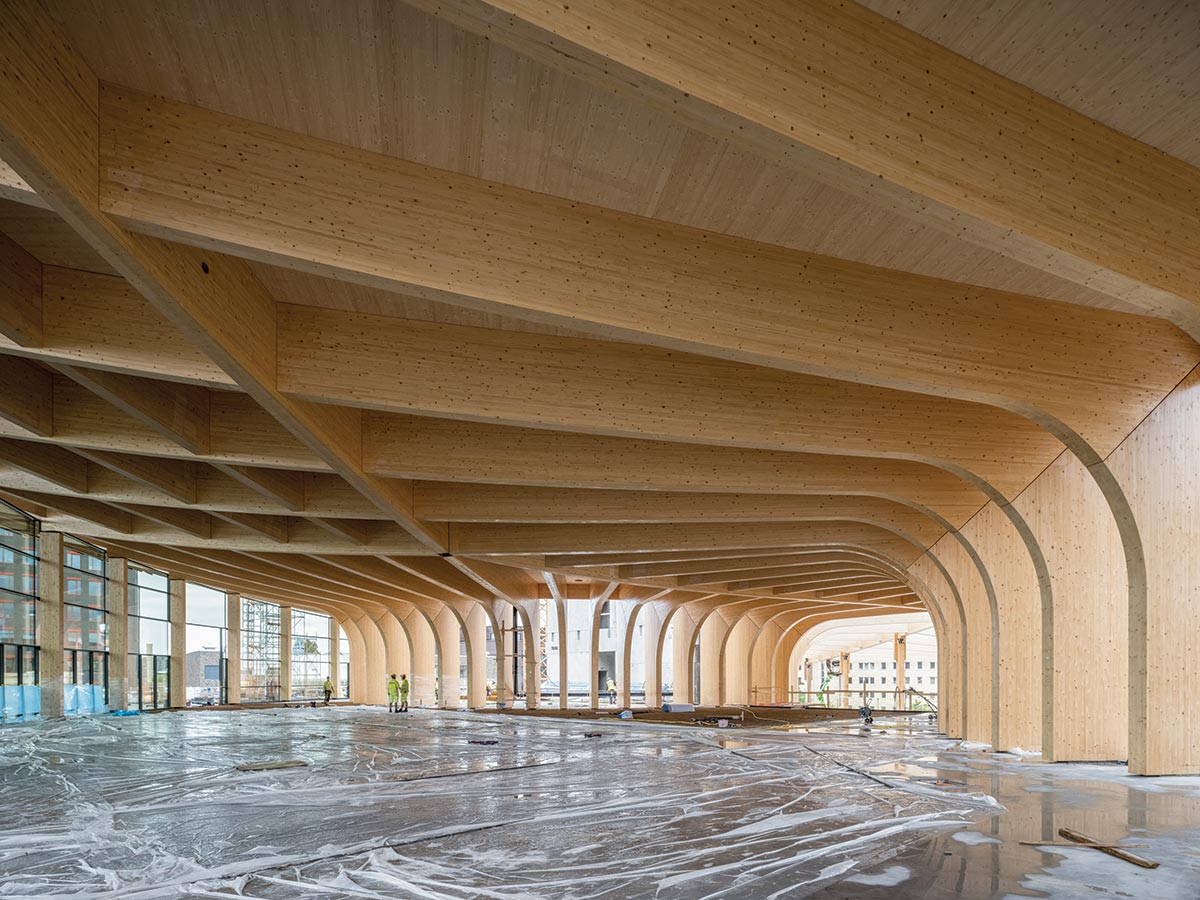
Photo © RASMUS HJORTSHØJ
Structural elements stand as tall as 50 feet and span distances of 115 feet.

Photo © RASMUS HJORTSHØJ
The project takes a decidedly modern approach to the country’s long tradition of wood construction. The vertical and horizontal structural members, made of glue-laminated timber (glulam), are enormous: some of the columns are as tall as 50 feet, while the beams span as much as 115 feet. Due to their size, they were sourced in Austria, where computer-controlled fabrication allowed the curved pieces to be cut with a high degree of precision. Metal connectors hidden inside the wood members provide rigidity. The floor and roof slabs are CLT (cross-laminated timber), which was sourced locally. Both the glulam and the CLT, made from spruce and pine, are 100 percent certified by PEFC (Programme for the Endorsement of Forest Certification).
Reflecting on timber construction, lead design architect Filip Francati says, “Despite strides in structural development, aesthetic expression hasn’t kept pace.” Stenberg Ringnér concurs, adding, “There is a perception that if you build in timber, you can only build boxes.” But the World of Volvo, he points out, has challenged this expectation. The project takes inspiration from nature to create organic forms, rendering them in organic materials.
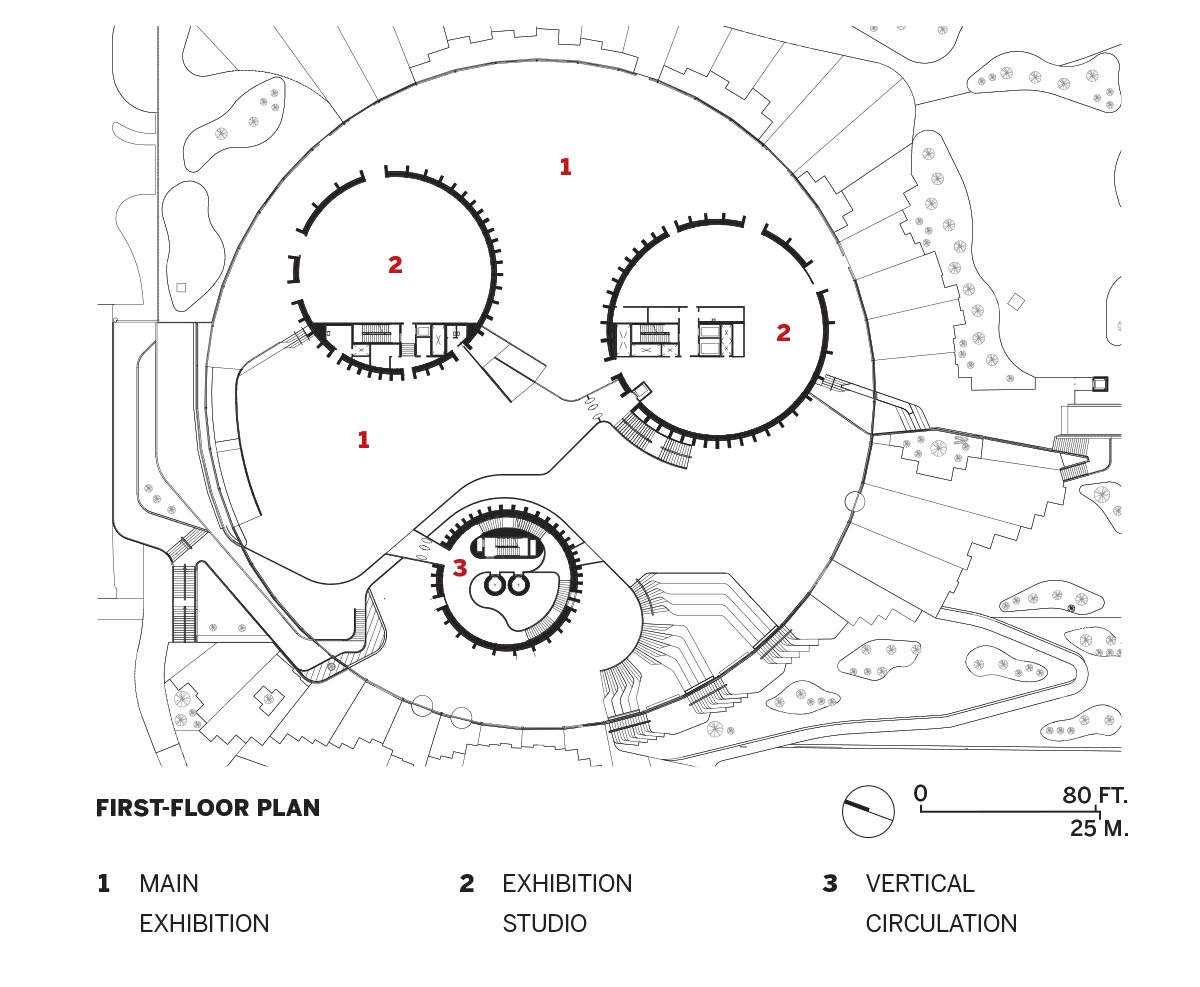
Image Courtesy of Henning Larsen
Credits
Architect: Henning Larsen — Søren Øllgaard, partner design director; Martin Stenberg Ringnér, associate design director; Filip Francati, lead design architect; Anders Astrup Andersen, Anders Åkesson-Björsmo, Carlos Seidenfaden, Fabia Baumann, Leonardo Castaman, Marina Gonzalez, Nanna Neergaard, Phillip Grass, Samuel Morris, Tilde Haremst, Uni Þeyr Jónsson, design team
Associate Architect: Fredblad
Engineers: Cedås Akustik (acoustics); Confire (fire); Granitor (electrical); Wiehag (glulam); Optima Engineering and BRA Teknik (concrete); Brion and Andersson & Hultmark (ventilation)
General Contractor: BRA
Consultants: Tyréns (accessibility)
client: AB Volvo and Volvo Cars
Size: 236,000 square feet
Cost: withheld
Completion date: 2024
Sources
Curtain Wall: Lindner Scandinavia
Interior finishes: Nordisol (acoustical ceiling); Lindner Scandinavia (woodwork); Kode Plåt (steel panels)
Doors: Vitrocsa
Project: Innoasis
Location: Stavanger, Norway
Architect: Helen & Hard
An outdated modernist office building is spruced up for the 21st century with a wood insertion
BY KATHARINE LOGAN
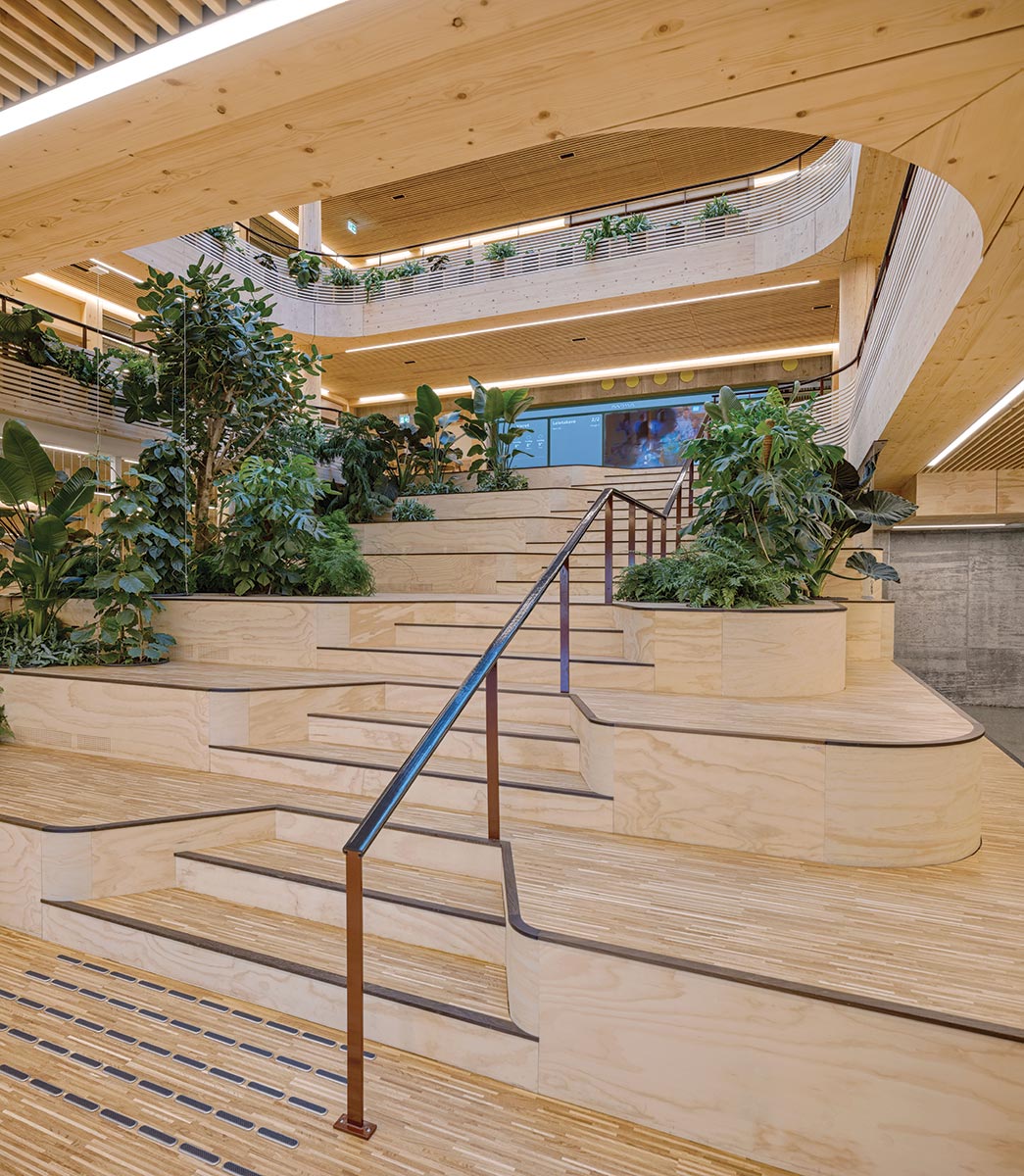
Photo © SINDRE ELLINGSEN
The atrium’s lowest level is a social stair.
If, in 1978, a Corbusian villa had migrated to Norway, fully embraced Brutalism, and tried to fit in as an office building, it might have turned out something like Sverdrupsgate 27, the headquarters for the then newly established Norwegian Petroleum Directorate in Stavanger. Starting with a two-story horizontal concrete block, complete with ribbon windows, ground-floor cut-aways, and even a ship’s-funnel-shaped stair tower, Sverdrupsgate 27 then took a note from its snow-savvy vernacular neighbors and adopted a pair of steeply pitched, height-doubling shed roofs. Volumetric, dynamically asymmetrical, and rational in plan, the building achieved a locally adapted, classically inspired iteration of late modernism that somehow managed to imply the not-yet-bitter promise of the petroleum age.
In time, however, Sverdrupsgate 27 lost its luster, the Petroleum Directorate moved on, and, by 2018, when the current owner, the development company Smedvig Eiendom, acquired the building, it had dwindled into an underperforming, energy-inefficient candidate for demolition—or complete overhaul. With Smedvig’s decision to renovate, Sverdrupsgate 27, now known as Innoasis, has acquired new life as a 43,000-square-foot light-filled hub for smart-city-focused innovation.
“In Norway—and I think everywhere—we have a lot of these poor-performing 1970s office buildings,” says Siv Helene Stangeland, founding partner at Stavanger-based Helen & Hard, architect for the renovation. “This project proves that you can reduce their climate footprints, create high-standard work environments, and provide them with a completely new identity that people really like.” Central to the renovation’s success is the integration of new timber elements that complement the original concrete structure while creating fresh, contemporary spaces.
The renovation inserted a prefabricated structure of peeled-log columns, glue-laminated-timber beams, wood joists, and slatted wood ceilings into an existing courtyard (formed by earlier additions to the building) to create a skylit atrium. Rounded wood galleries at each floor level overlook the new space, and the original concrete stair spirals up through it. Floored with wood and filled with plants, the atrium facilitates informal meetings that foster connections and collaborations among the building’s start-ups. It is also open to the public via a ground-floor café.
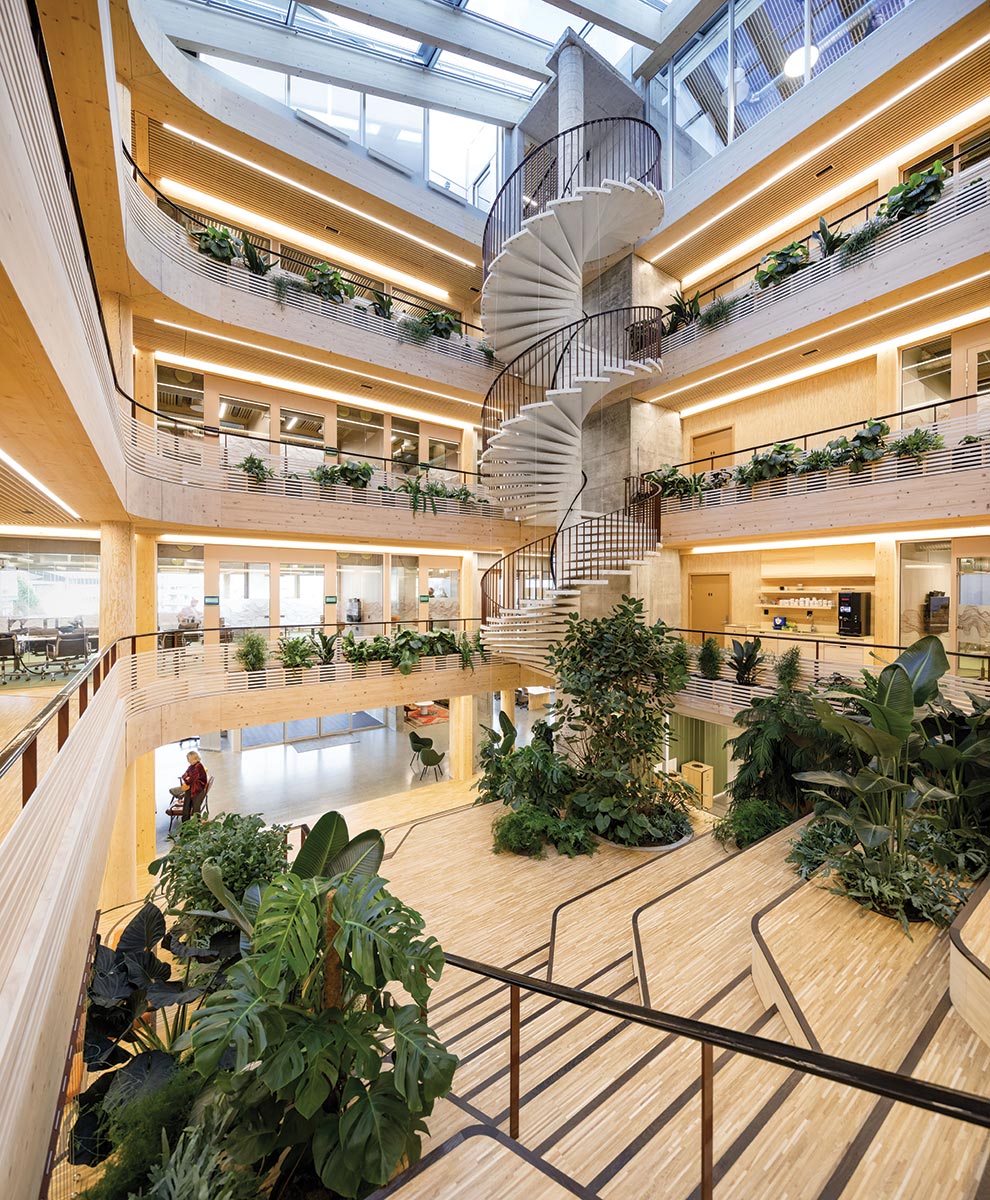
Photo © SINDRE ELLINGSEN
A spiral stair connects five stories. Outside, Innoasis has been reclad with wood on some facades.
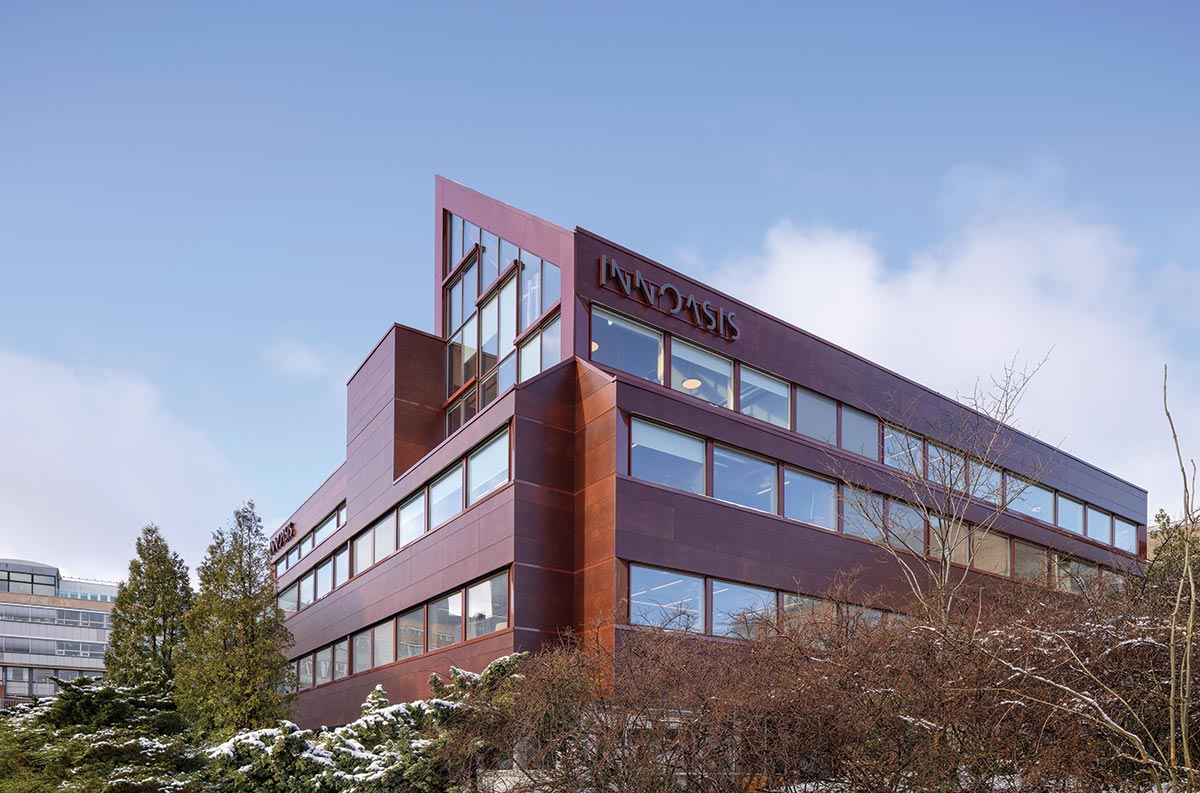
Photo © SINDRE ELLINGSEN
Compared to other forms of mass timber, the log columns, which come from sustainably managed Norwegian forests, required very little machining and no gluing. And, while initially the client took some convincing that the inevitable checks and fissures that unprocessed heavy timber develops as it dries need not be considered unsightly, “now everyone thinks they’re beautiful,” says Stangeland. “Seeing these trunks gives a much closer connection to natural materials and where they come from.”
In addition to the aesthetics of the wood, enhanced by its contrast with the concrete structure through which the atrium is reached, the space derives much of its character from its acoustics. Ribbed and curved wood surfaces, supplemented with acoustic panels, hush the hall. “It’s very calm,” says Stangeland. “Although it’s open to four floors, and people are talking and meeting and circulating, it has a very good atmosphere.”
The slatted ceilings carry through as part of the acoustic strategy for the concrete structure as well, where they are fitted into the existing site-cast T-beams’ irregular intervals. (This feat was made possible by the use of a digital twin, based on a LiDAR laser scan of the original structure, which generated the measurements for prefabricating elements to fit.) To provide flexibility for future changes, the ceiling also contains infrastructure to support cellular offices—should they be preferred—with built-in wall tops to which dividers can be affixed, and ventilation and lighting spaced at the intervals of office modules.
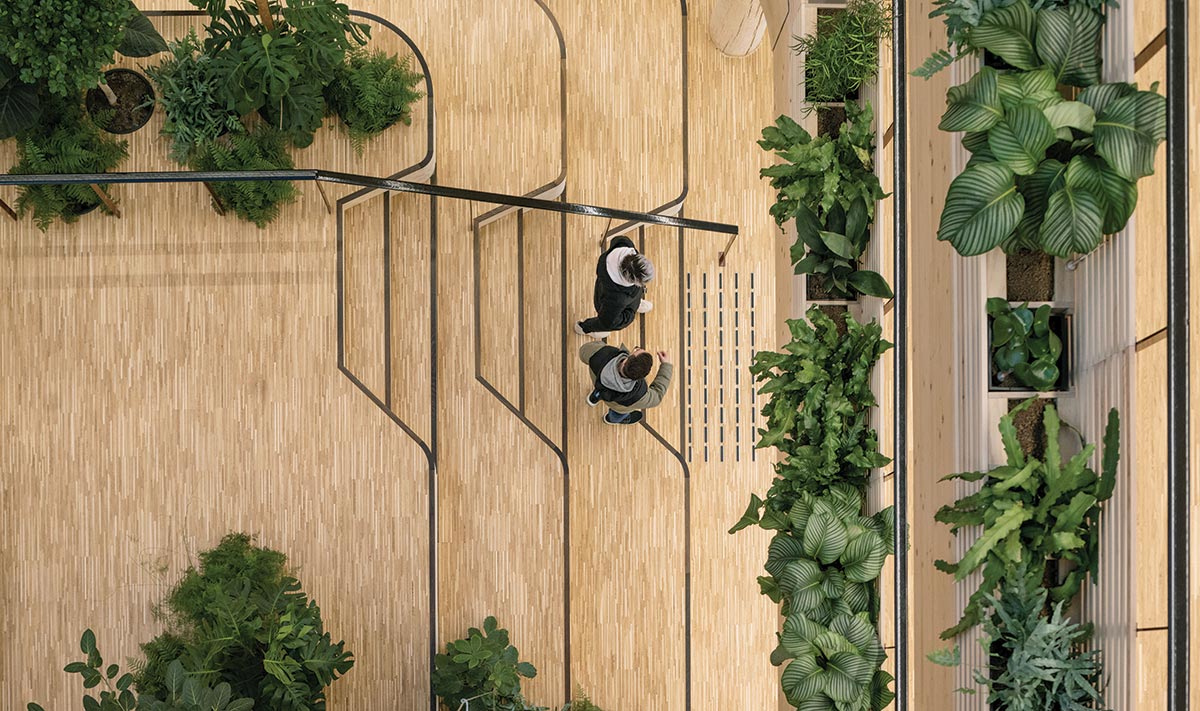
Photo © SINDRE ELLINGSEN
Greenery abounds in the atrium, while sloped roofs allow daylight into the fourth-floor offices.

Photo © SINDRE ELLINGSEN
While the timber atrium is the signature element in the building’s new identity, the project also entailed removing a hodgepodge of extensions between the original roofs, and building two new pitched roofs to complete a square around the atrium. As well as shedding snow, the roof forms allows light and air in fourth-floor offices, and generates sectional variety, including lofts and mezzanines, which make for a dynamic spatial experience.
The envelope was upgraded with new windows, insulation, and cladding—on some facades in wood—complemented by improved environmental controls and solar panels. Together, these enhancements, which the digital twin facilitated, achieved a 50 percent reduction in the building’s carbon footprint, compared with a reference building.
“When you’re working with an existing building, the question is always how you can create the possibility to adapt,” says Stangeland. “Our attitude is that the aesthetic experience is much richer if you can retain more of the old and add new where you need to.” Back when the original Sverdrupsgate 27 was new, the building—and the work it housed—played a significant role in ushering the region into the oil age. The hope now is that the rejuvenated building, with its expressive wood elements, will play an equally significant role in the quest to start up a more sustainably driven era.
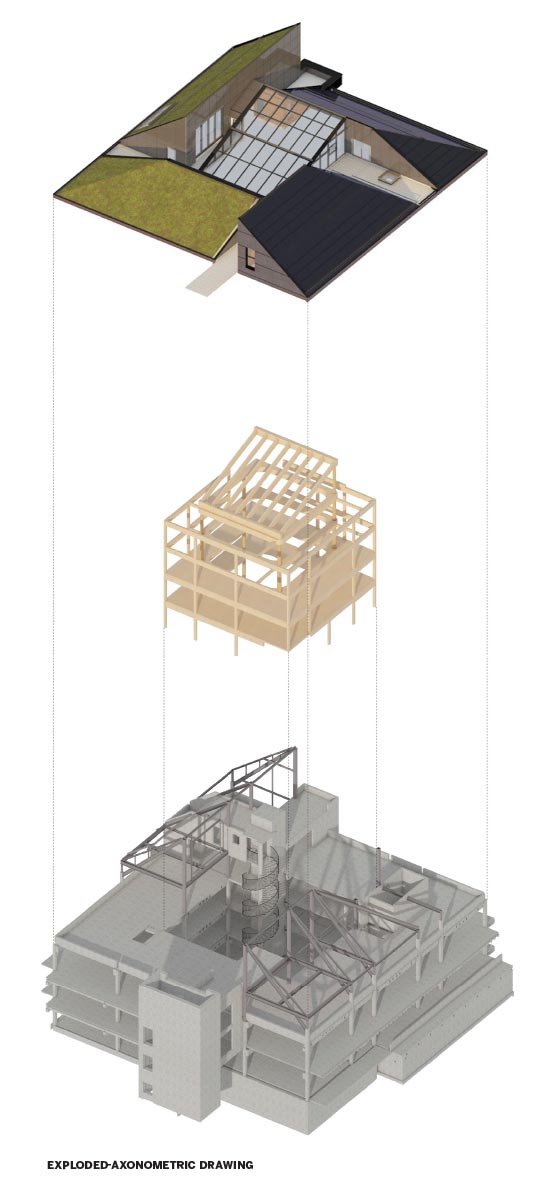
Image Courtesy of Helen & Hard
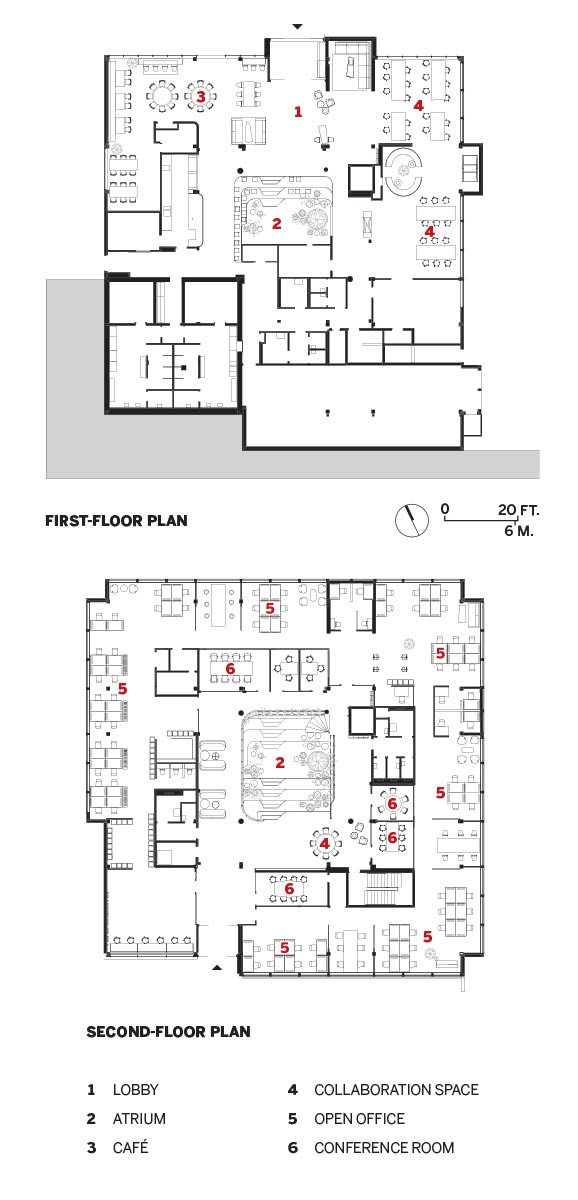
Image Courtesy of Helen & Hard
Credits
Architect: Helen & Hard — Siv Helene Stangeland, Reinhard Kropf, creative directors; Håkon Solheim, project architect; Ingrid Sekse, architect
Consultants: Norconsult (technical); Brekke & Strand Akustikk AS (acoustic); Konsepta (fire); Procon (structure); Veni (energy and VDC/BIM)
General Contractor: Faber
client: Smedvig Eiendom
Size: 43,000 square feet
Cost: $18.7 million
Completion date: October 2022
Sources
Timber construction: Woodcon
Quick Takes
Projects from around the globe demonstrate diverse approaches to building with wood
JARDÍN ANATOLE
In Mexico City’s Colonia Polanco neighborhood, Dellekamp Arquitectos recently completed Jardín Anatole, a four-story timber structure on a lot that had previously been the garden of a historic residential building next door. The new 10,000-square-foot structure, which houses a clothing store, a furniture showroom, and office space, is built almost entirely of oak from northern Mexico. Jardín Anatole is the country’s largest and tallest glulam building, according to the architects. Though primarily made of wood, it incorporates some concrete elements, as in its circulation core and an existing party wall provided by the neighboring building. The interiors are column-free, due to a perimeter structure that includes a second-story glulam truss and, on the levels above, closely spaced finlike elements, also of glulam. At the base, V-shaped steel perimeter columns allow the glass-enclosed “wood box” to float visually above the surrounding terraced outdoor space. Joann Gonchar, FAIA
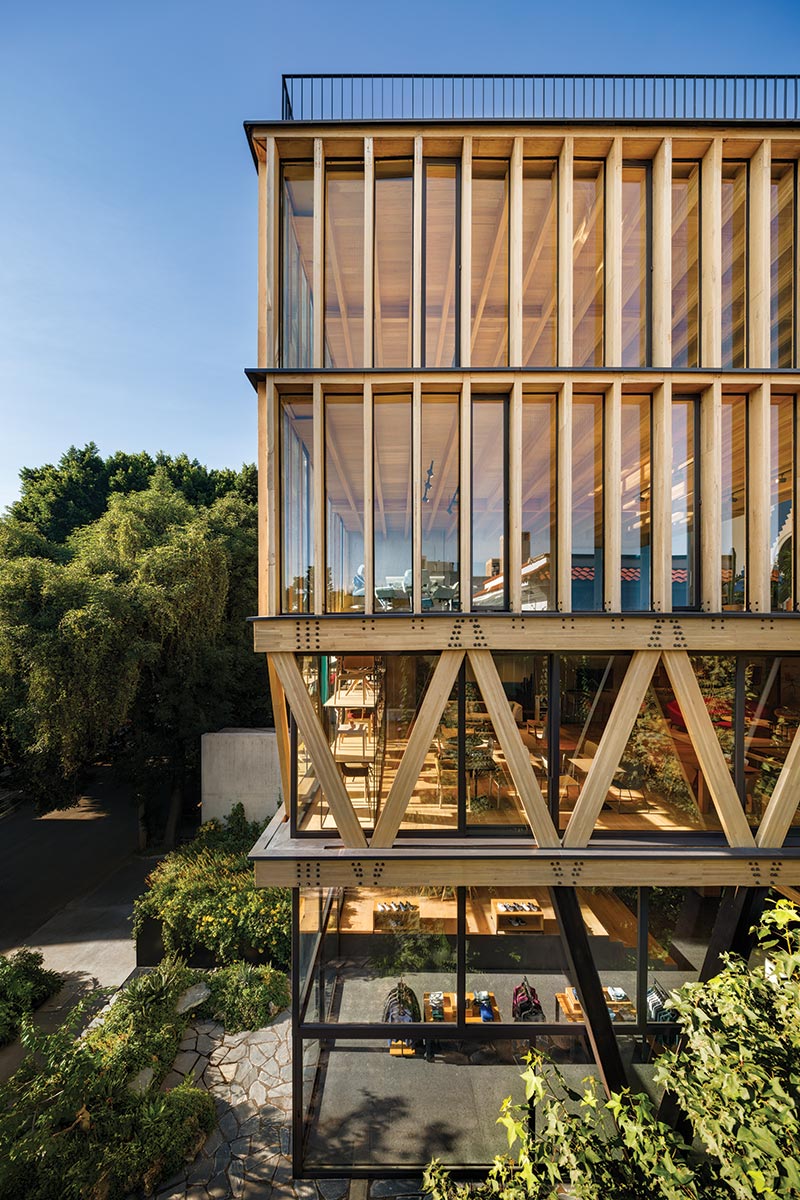
Photo courtesy of RAFAEL GAMO
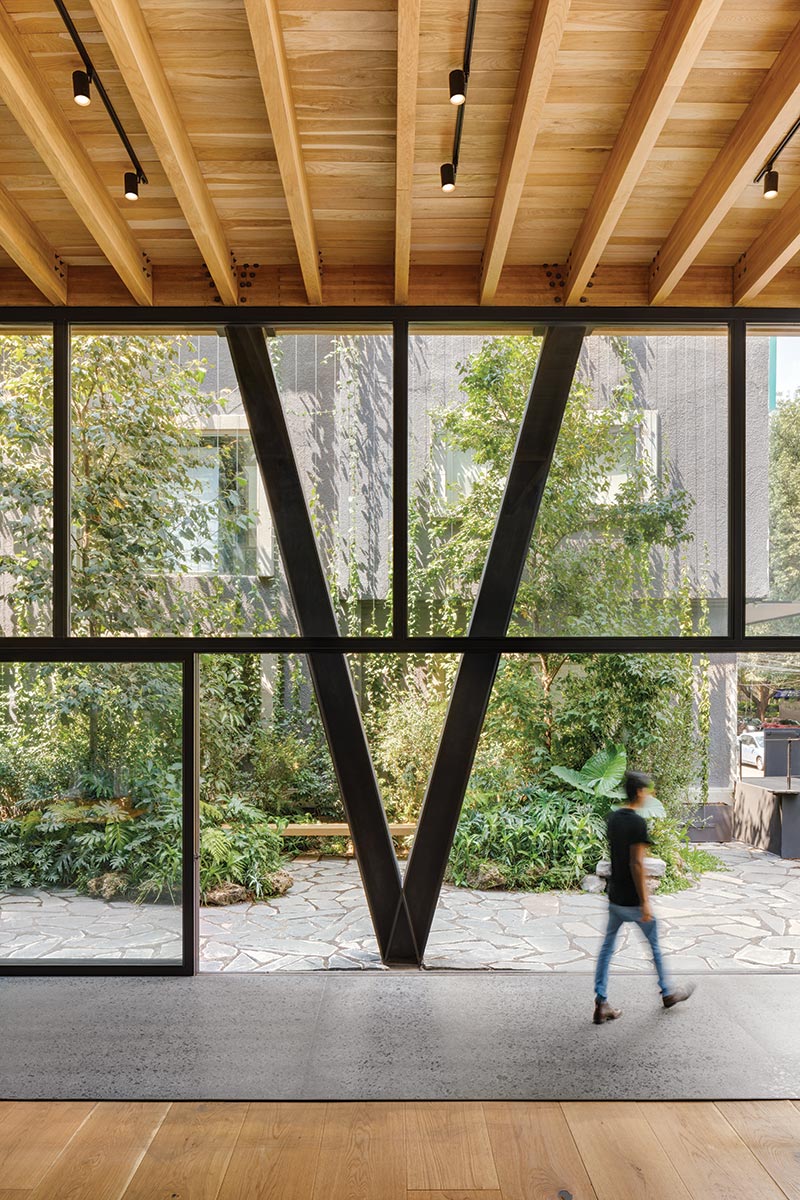
Photo courtesy of RAFAEL GAMO
FLORA
Gently curving elevations, punctuated by full-height windows and slatted-wood screens, will wrap Flora, a sculptural building in the Paris suburb of Nanterre. Designed by Vancouver-based mass-timber specialist Michael Green Architecture (MGA), with the French firm CALQ Agence d’Architecture as the architect of record, this nine-story, 90,000-square-foot residential-and-commercial project is slated for completion in 2024, as part of a broader plan to develop the emerging Les Groues district, not far from the business center La Défense. Triangular in plan, with a central courtyard, the massing consists of a two-story podium with two interconnected towers above it. The top seven floors will be residential, with a mix of market-rate and social-housing units, while the lower two stories will be a mix of retail, office, and coworking spaces. The round-cornered facades, dotted with balconies, will meet the street in a modern twist on the classic 19th-century facades of Paris, a city whose urban plan creates many triangular sites. With a primary structure of CLT and glulam above level three, “it’s really a showcase of what’s possible in wood,” says MGA founder Michael Green. Commissioned by developer Woodeum, Flora has already won the 2022 Bâtiment Bas Carbone Award for implementation of low-carbon practices. Ilana Herzig

Image courtesy of MICHAEL GREEN ARCHITECTURE
ESBJERG MARITIME CENTER
This drumlike Maritime Center, designed by Snøhetta and WERK Arkitekter, in the Danish seaport town of Esbjerg, revolves around the notion of community. Forging a connection between Denmark’s west coast and the North Sea, the 40,900-square-foot laminated-pine structure sits on a waterfront site along boat slips, and hosts training and educational workshops as well as water sports. Powered by rooftop solar panels, the new facility, with its ring-shaped double courtyard, forms an amphitheater partly open to the elements, and accessible by land or sea—via boat launch, dock bridge, and footpaths. The building is clad and roofed in thermally modified pine from northern Denmark, echoing the craft of Nordic wood boat-making. Its elliptical plan encircles a raised terrace punctured by two oblong apertures that filter light into lower-level boat storage. Constructed to withstand extreme climatic events, the poured-in-place concrete first floor can accommodate high water. The vertical fins between the staggered windows evoke the rhythm of waves. With rectangular openings of varying sizes and proportions, the building glows like a lantern by night. IH

Photo © WICHMANN+BENDTSEN PHOTOGRAPHY
SCHOOL AND HOUSING
At Issy-les-Moulineaux, just outside Paris, the anticipation of Metro Line 15 (due to open late 2025) has prompted redevelopment of the surrounding neighborhood. Among the new buildings is a 2021 mixed-use complex by architects Brenac & Gonzalez, comprising a school and 104 social-sector apartments. Commissioned in 2017 by housing company Seine Ouest Habitat et Patrimoine (SOHP), the project features two distinct parts—a four-story concrete base containing two underground parking levels and two above-grade school floors and, rising from this podium, two eight-story residential blocks, offering a range of typologies from studios to four-bedroom apartments. Around concrete stair-and-elevator cores that ensure wind bracing, timber specialist Mathis built the dwellings from prefabricated CLT panels held together with metal connectors. Clad in a mix of pre-grayed larch and stainless steel, the apartments all feature balconies, realized as hybrid steel-wood structures bolted onto the facades. Timber offered advantages to both client and architect: for SOHP, it helped meet environmental targets; for Brenac & Gonzalez, wood’s relative lightness allowed construction of the housing on a different structural grid from the school, while the swift assembly of factory-fabricated components ensured they met the strict completion deadline. Andrew Ayers
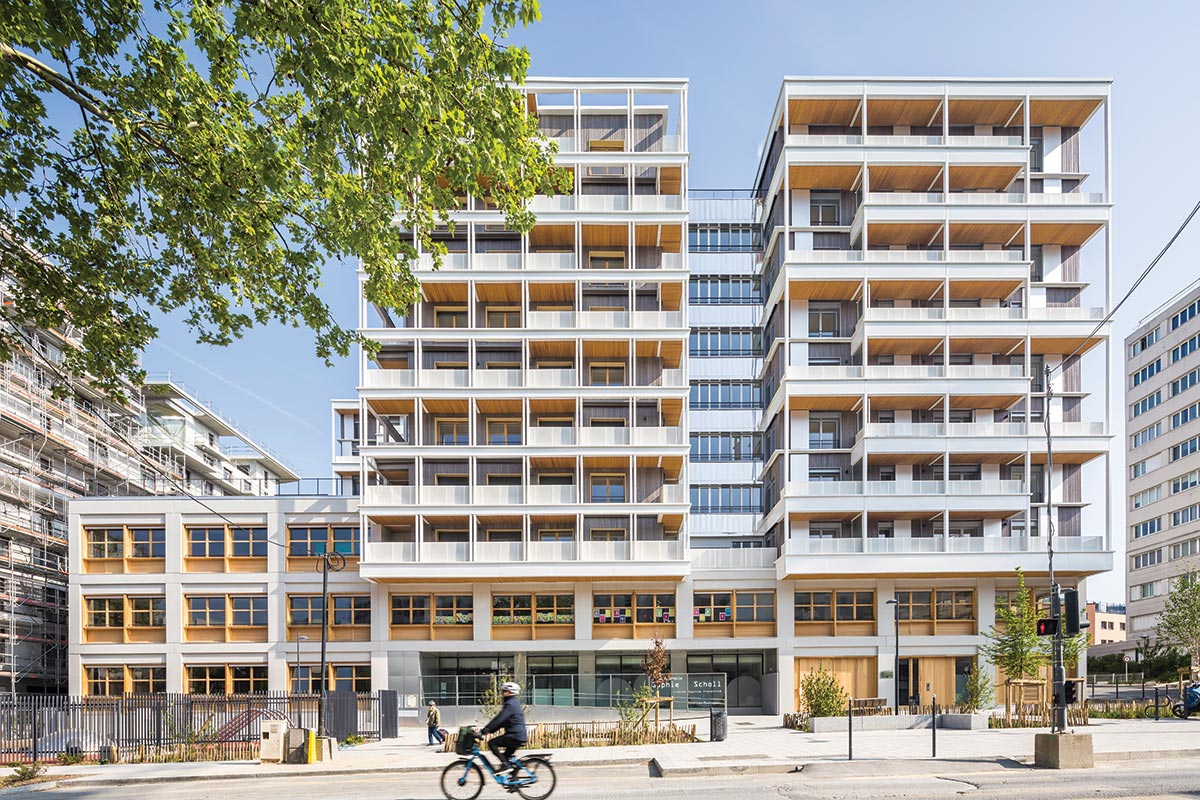
Photos © Sergio Grazia
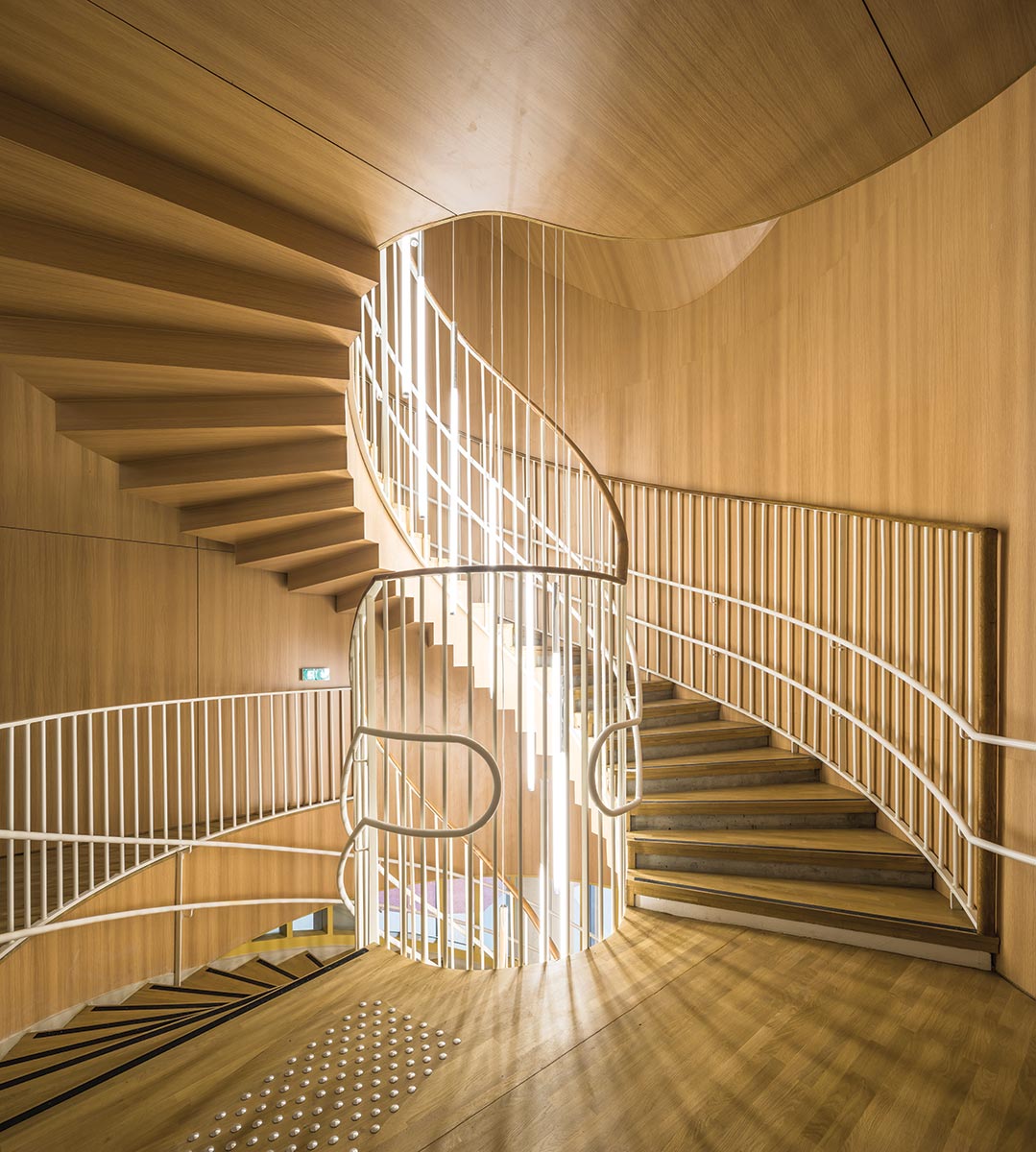
Photos © Sergio Grazia
KLOBOUCKÁ LESNÍ HQ
Nestled in the Czech town of Brumov-Bylnice, the headquarters for wood-products manufac-turer Kloboucká Lesní is an elongated structure with a steeply pitched roof and gabled ends, each shaped like an upward-pointing arrow. Mjölk Architekti, based in the Czech city of Liberec, designed it with a modular timber shell constructed from laminated-spruce “bioboards.” The company, which aims to advance sustainable forestry through “ancestral knowledge and techno-logical inquiry,” settled into the 10,800-square-foot building in 2022. Set against a moun-tainous backdrop, this multifunctional space—a stone’s throw from their manufac-turing center—includes areas for events and relaxation. Sourced predominantly from local timber grown in the surrounding forests and engineered on-site, the structure has a load-bearing glulam skeleton braced by steel, and a concrete core. With much of the roof covered by photovoltaic panels and a central boiler fueled by wood chips produced at the compound, the building generates enough energy to meet its own requirements. IH
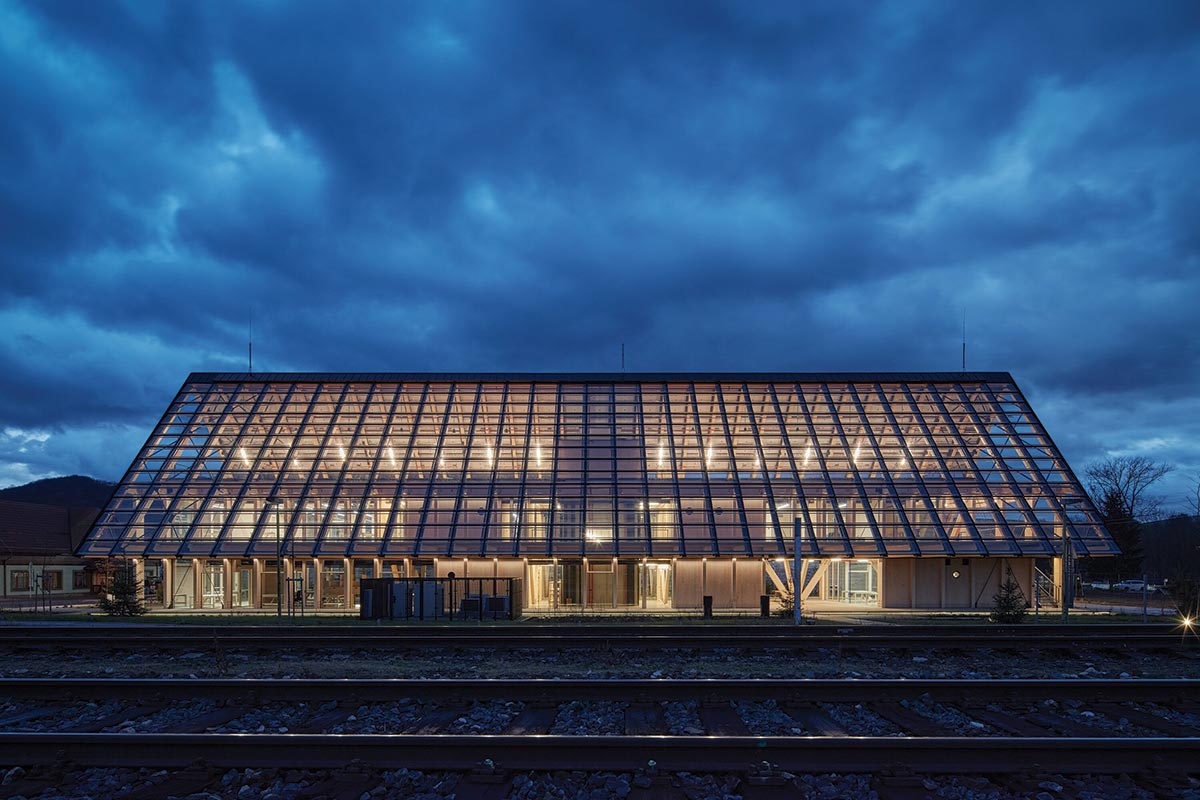
Photo © BOYSPLAYNICE
GLOBEVILLE LIBRARY AND APARTMENTS
Of Denver’s 78 neighborhoods, the name Globeville is among the most fitting. A multicultural, working-class enclave in the city’s northern reaches, it has been home to generations of immigrants—first from Central and Eastern Europe and later Latin America—who found employ in the neighborhood’s namesake smelter. Globeville is also known for its disconnections. Bounded on the east and south by the South Platte River and cleaved by railway lines, the former company town found itself fractured and even more isolated following the mid-20th-century construction of two major interstates that bisect its heart, displacing communities and leaving the cloistered and polluted neighborhood beset with neglect.
Efforts now under way to mend and revitalize Globeville include new affordable housing and overdue community resources. Combining both is a forthcoming project by Chicago-based John Ronan Architects (JRA) for the Globeville Development Partners, which will create a new branch of the Denver Public Library, topped by 173 units of family-oriented mixed-income housing, in response to encroaching gentrification. The design intentionally reflects the neighborhood’s gritty character through its cladding of two U-shaped hybrid mass-timber volumes, one in galvanized steel and the other in corrugated weathering steel, encircling a landscaped courtyard for residents and, in areas, library patrons.
Originally envisioned as a “stack of wood blocks,” the building has a poured-in-place concrete podium beneath five residential floors constructed with cross-laminated timber. Engineered wood also extends to nonstructural elements, including plywood in the library interior—shelving and ceiling and wall cladding—in another nod to Globeville’s blue-collar roots.
“There’s a theme of dirty/clean in the project, with Globeville being home to these historically dirty industries that need to be cleaned up,” says Ronan, “so CLT was fed into that narrative, in that it’s a very clean, sustainable technology—a new direction for Globeville.” Matt Hickman
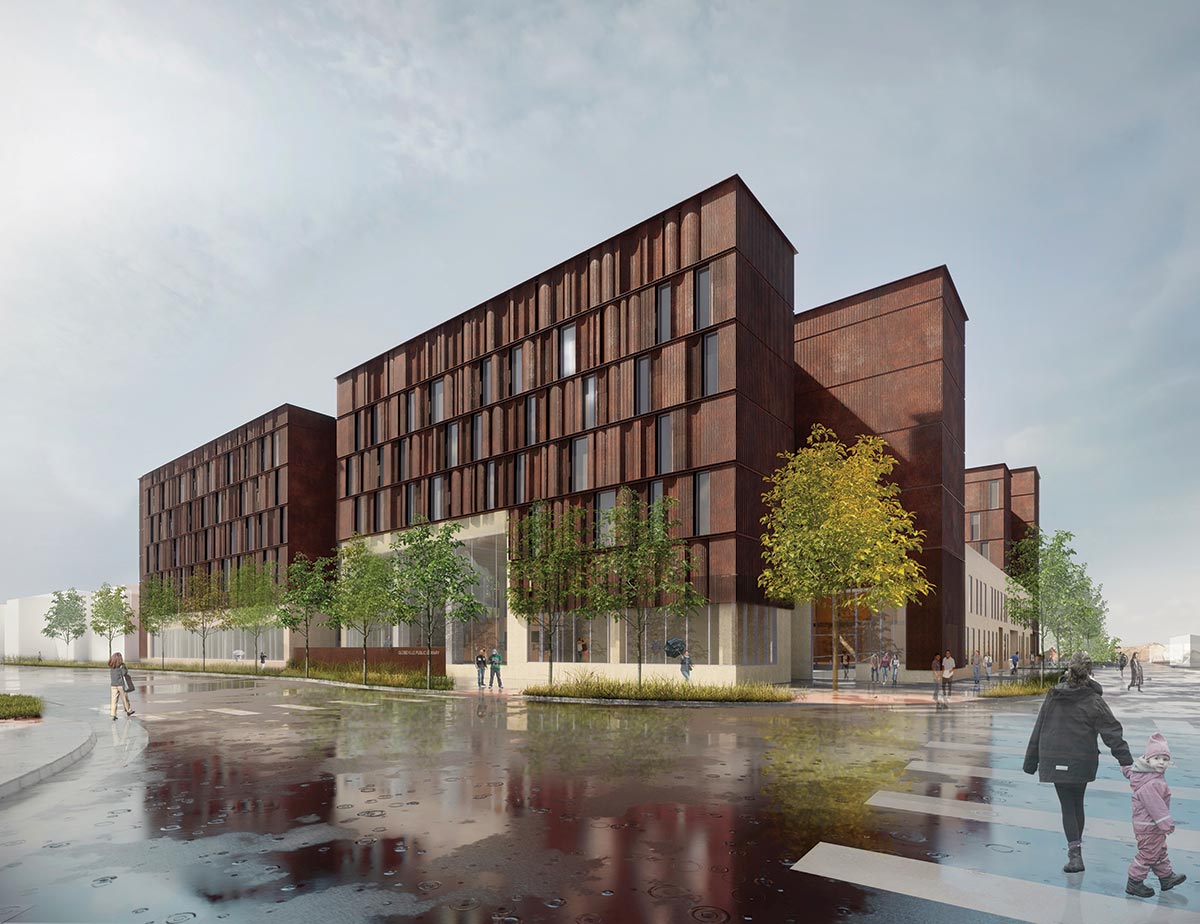
Image © John Ronan Architects
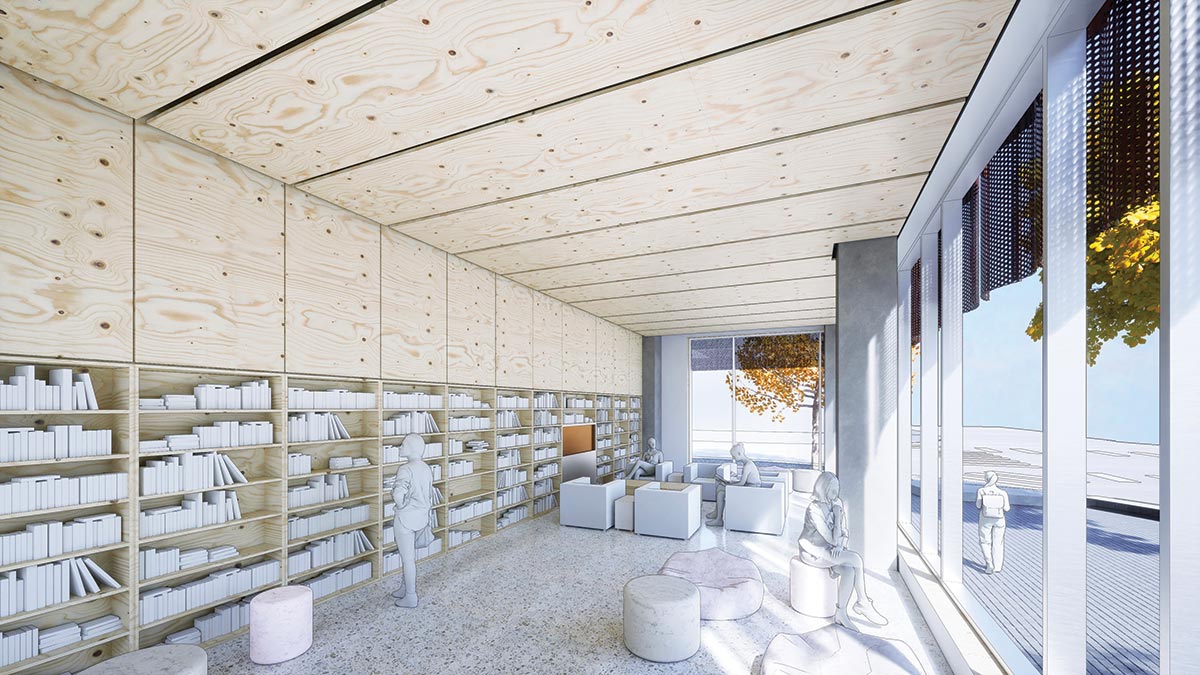
Image © John Ronan Architects
UNL COLLEGE OF ARCHITECTURE
Omaha-based HDR has garnered attention for its typology-spanning mass-timber projects, yet all these buildings, completed and in progress, are located outside the Cornhusker State (with most coming from the firm’s busy British Columbia offices). HDR is now, however, using engineered wood in its own backyard for a major addition at the University of Nebraska-Lincoln’s College of Architecture (plus one other mass-timber project elsewhere in the state). They’re joined by Boston-based NADAAA, which has won praise for its timber-and-steel-framed North Hall at the Rhode Island School of Design (RECORD, March 2020)—“not extensive experience, but substantial enough that it was something that we could bring to the table,” says NADAAA founder Nader Tehrani. Now under construction as the second phase of a larger overhaul of the College of Architecture, HDR and NADAAA’s four-story linear expansion built from glulam and CLT replaces the 1950s-era “stacks” addition at Architecture Hall West, yielding 14 new studios, a student lounge, and more. “It’s an interesting time line of buildings,” says HDR design director Tom Tren-olone, of the college’s eclectic assemblage of structures—which includes two main halls, completed in 1892 and 1912, a connective atrium known as the Link that debuted in 1987, and soon this mass-timber addition. “It’s very appropriate for a college of architecture.” MH

Images courtesy HDR + Nadaaa
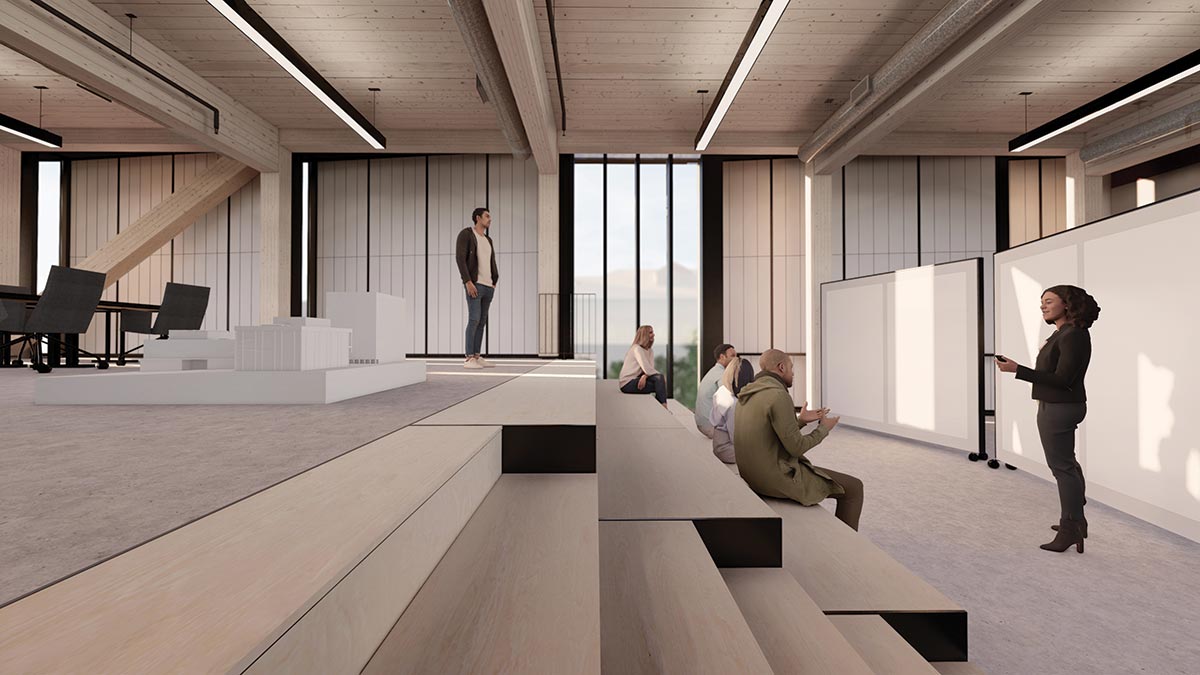
Images courtesy HDR + Nadaaa
TIMBERLANDS CENTER
Site work has commenced on the Anthony Timberlands Center for Design and Materials Innovation at the University of Arkansas. This is the first project in the U.S., and the first built with timber, for Pritzker Prize–winning firm Grafton Architects, which is working with local firm modus studio. As part of the Fay Jones School of Architecture and Design, it will be a space for fabrication, research, and development, constructed significantly of timber and wood sourced in Arkansas, the eighth-largest timber producer in the U.S. It will be home to the school’s ongoing design-build and graduate programs and collaborative efforts with partners in the state’s forest industries. It is expected to complete at the end of 2024. Josephine Minutillo
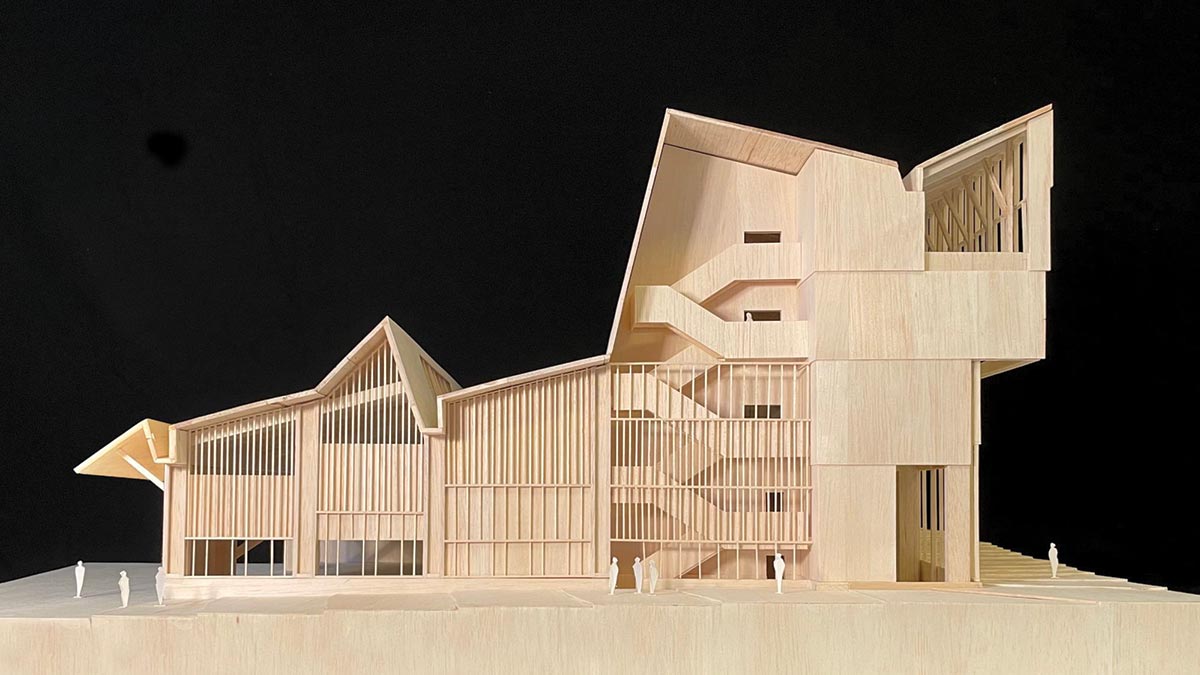
Photo courtesy Grafton Architects and Modus Studio
OFFICE BUILDING
“The right material in the right place,” says architect Anne Carcelen of this eight-story office building in Paris’s 19th arrondissement. One element in the redevelopment of a former industrial area, and completed in 2021, the project is located on an awkward wedge-shaped site next to railroad tracks. The partly state-owned developer, Icade, wanted to set an example by building in mass timber, and commissioned Carcelen for her experience with the technique, which includes the 2014 Lycée Nelson Mandela in Nantes, designed when she was a partner at Leclercq Associés. With a concrete elevator core and concrete base, the cross-laminated-spruce frame, which is left largely exposed inside, carries prefabricated concrete-slab floors, chosen for their acoustic properties and speed of assembly.
A similar pragmatism prevails in the treatment of the timber-framed facades, using folded red-brown zinc cladding on the two longest eleva-tions—both diffusing train noise and evoking the site’s industrial past—and, at either end, glass curtain walls. BIM, employed for design, construc-tion, and maintenance, was essential in realizing the many one-off pieces required for the building’s irregular shape. A proponent of environmentally responsible construction, Carcelen is now bringing her expertise to the U.S. as a partner in the New York firm OulipO. AA
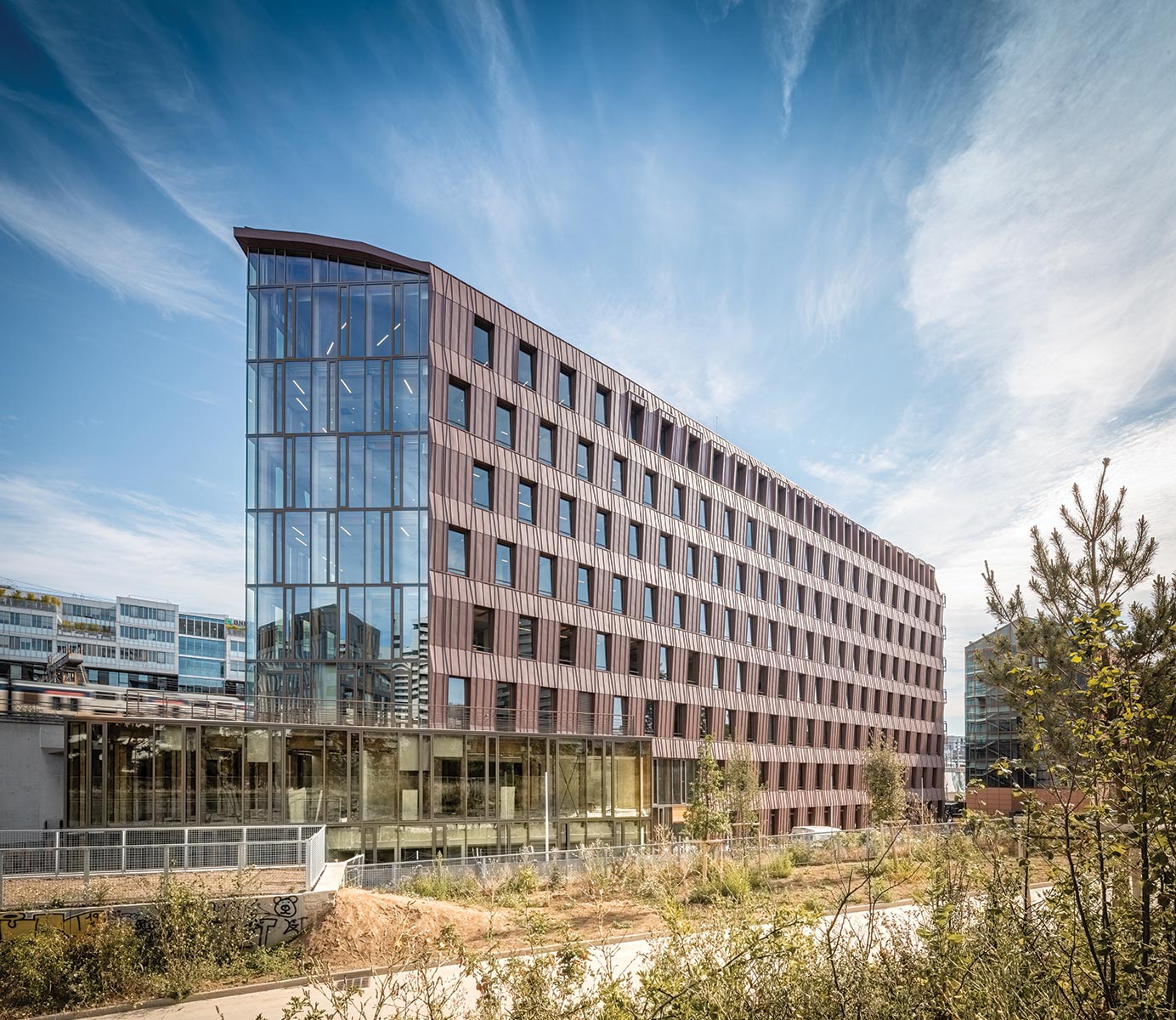
Photo © Nicolas Grosmond
PORTLAND MUSEUM OF ART
LEVER Architecture, a firm based in Portland, Oregon, noted for its pioneering embrace of mass-timber construction, is making its mark on the other Portland—the similarly forest-flanked one in Maine—with a $100 million revamp of that city’s most venerable public art institution. The first expansion of the Portland Museum of Art (PMA) in four decades, it includes a new 60,000-square-foot wing that knits together PMA’s quartet of disparate but architecturally significant buildings at Congress Square. Adjacent to the museum’s Payson Building (1983), the six-story addition will include gallery space and community gathering areas, with a design incorporating mass timber, terra-cotta, and glass. “The possibility of using Maine lumber is really exciting,” says LEVER principal Chandra Robinson, noting that sourcing local timber is “something we do in our projects, because we feel it helps balance the rural and urban equity, so we’re pushing more jobs and manufacturing back into rural areas.” MH
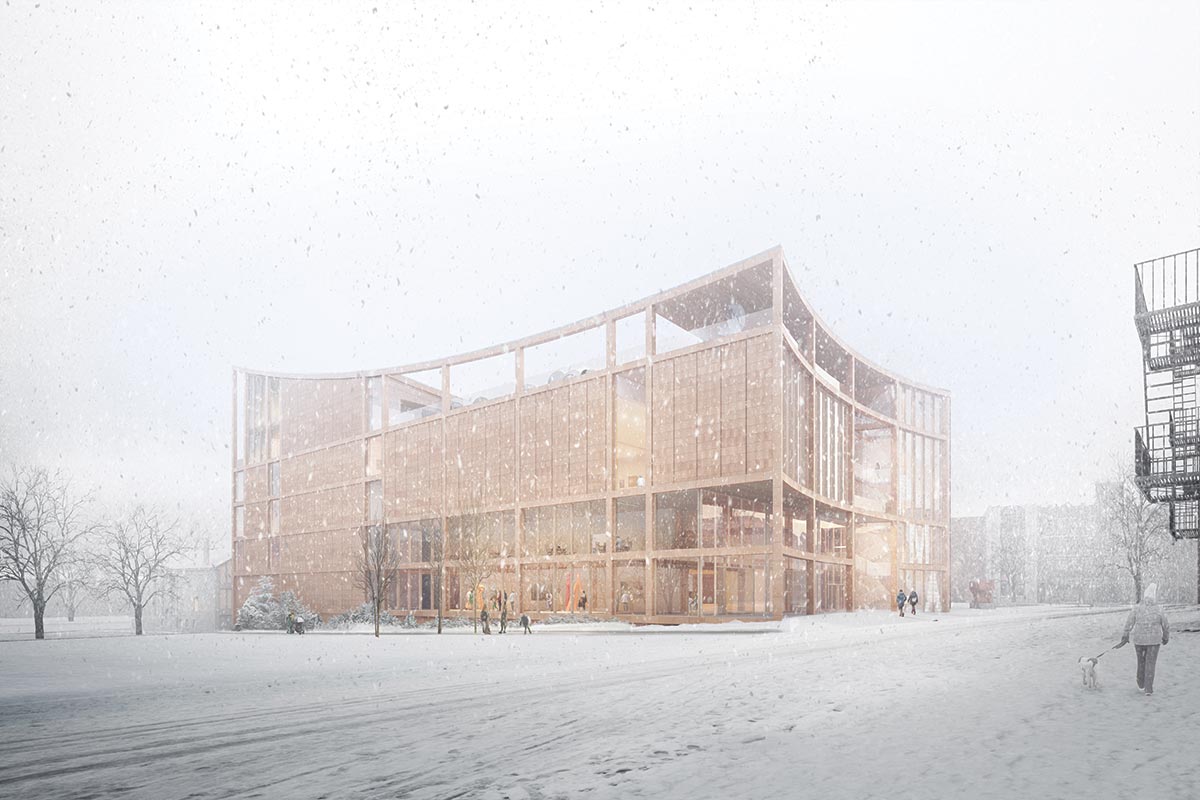
Image courtesy of DARC STUDIO, COURTESY PMA, LEVER ARCHITECTURE, DOVETAIL DESIGN STRATEGIES
SUMMIT BUILDING
A 1.5 million-square-foot extension of the Seattle Convention Center, the Summit building was completed in January. Designed by local firm LMN Architects, the centrally located urban project has six levels of event spaces, which include an 85,000-square-foot ballroom on the top level. The steel-framed building is visually open to the street via extensive glazing on the exterior, and LMN incorporated warm timber accents throughout the interior as a nod to the regional heritage of the lumber industry. The amphitheater-like social stairs, made from madrone hardwood native to the Pacific coast, cascade within the west-facing glass curtain wall from the fifth floor to the ground level. Above them hangs a canopy of dangling Douglas fir “combs.” This effect is repeated on the ceiling of the ballroom, where the combs are made up of wormwood—wood salvaged from log booms off the Washington coast in the Salish Sea, which is uniquely textured from the tunneling habits of Teredo clams. Pansy Schulman
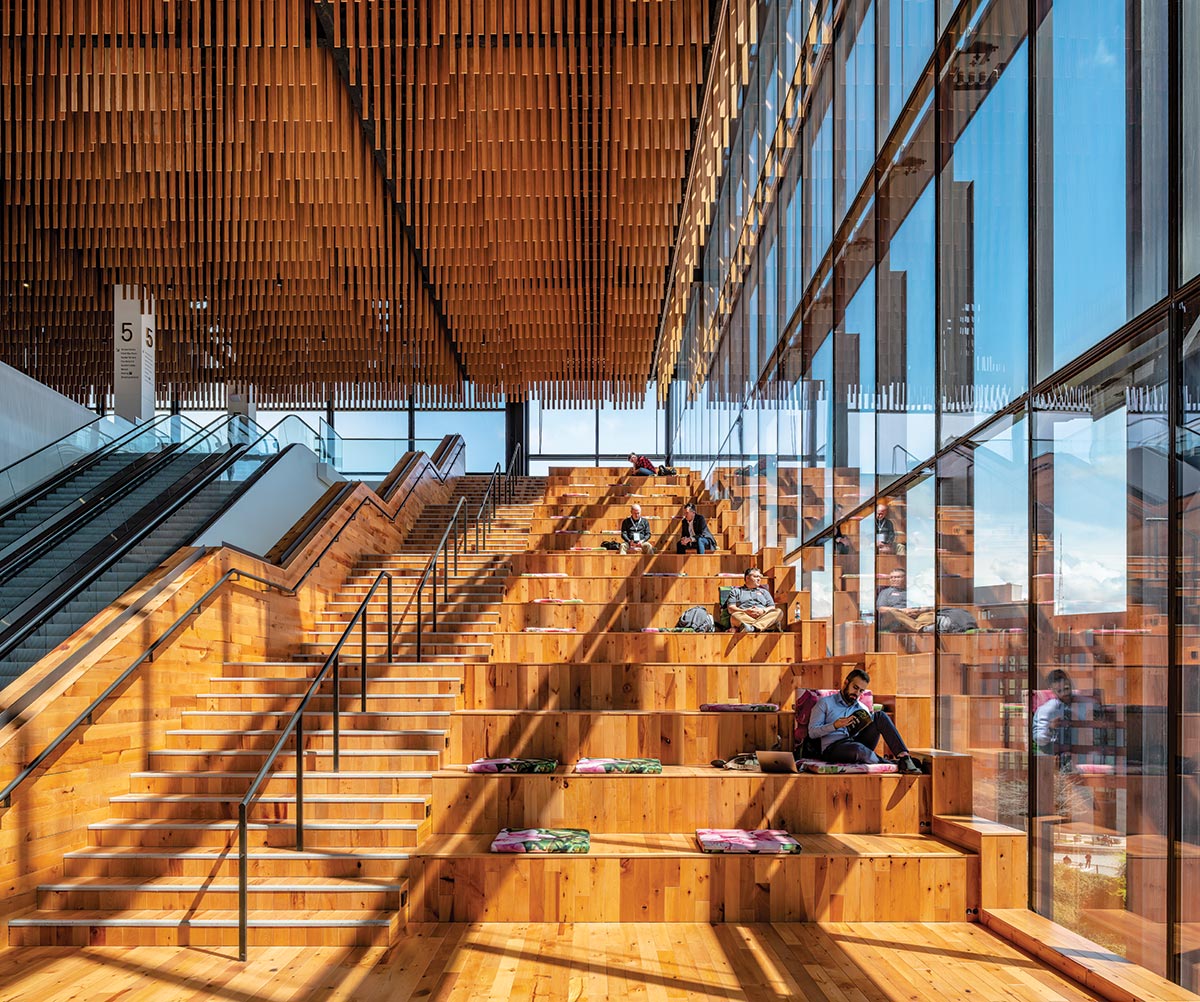
Photo © TIM GRIFFITH
NEW YORK CLIMATE EXCHANGE
The transformation of Governors Island continues with the April announcement that Stony Brook University will serve as anchor institution for a $700 million climate-solutions hub, planned for the 172-acre former military outpost in the heart of New York Harbor. Dubbed the New York Climate Exchange, the campus will be developed over two phases, with Skidmore, Ownings & Merrill (SOM) leading a team with three other firms. The design, as the firm’s own description puts it, intends to “weave new architecture into the island’s beloved park to create a living laboratory for research, education, and public enjoyment.” The first phase of the 400,000-square-foot facility will encompass a pair of sinuous mass-timber buildings by SOM. Centered around several acres of newly created public green space near the island’s eastern shoreline, these multistory pavilions will host spaces dedicated to education and research, and incorporate myriad sustainability strategies to help satisfy the holistic—and ultra-stringent—performance metrics of the Living Building Challenge. MH
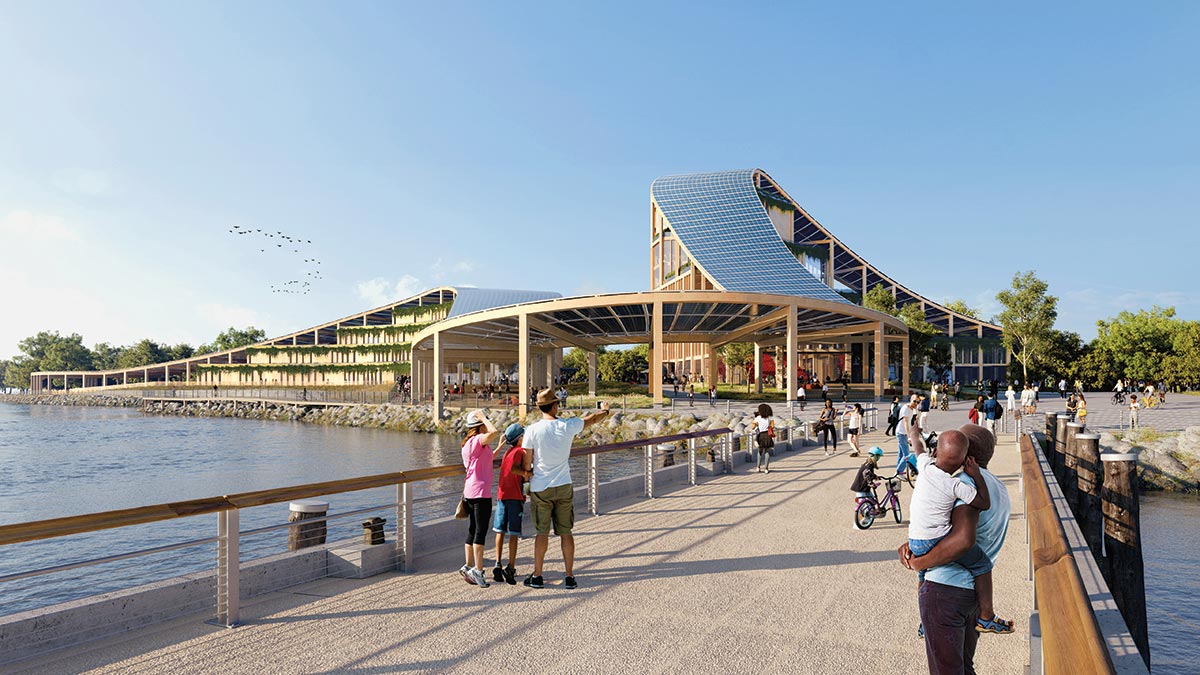
Image © SOM, BRICK VISUAL
H1 APARTMENT BUILDING
At the Zwhatt development in Regensdorf, north of Zürich, Boltshauser Architekten is building a 24-story mass-timber apartment block due for completion in 2024. One of two residential towers programmed in Peter Märkli’s master plan, H1, as it is known, will contain 150 units ranging from studios to family duplexes, as well as a café and a coworking space in its lower levels. Winners of a 2019 design competition, Boltshauser proposed timber both for its low-carbon credentials and its speed of construction—approximately six months faster than an all-concrete tower, the architect estimates. Structurally hybrid, H1’s first five levels (including two basement floors) are poured-in-place concrete, as is the central elevator tower; around this core rises a timber/concrete structure comprising columns, beams, and facades in Swiss beech, with prefabricated concrete floors. Wind loads are transferred via the floors to the core and down to the podium, a solution that also fulfills seismic requirements. Outside, the red-metal-clad elevations feature brise-soleils carrying photovoltaic cells, while, inside, the timber/concrete structure is fully expressed. Residents will enjoy living rooms with loggias as well as highly flexible layouts. AA
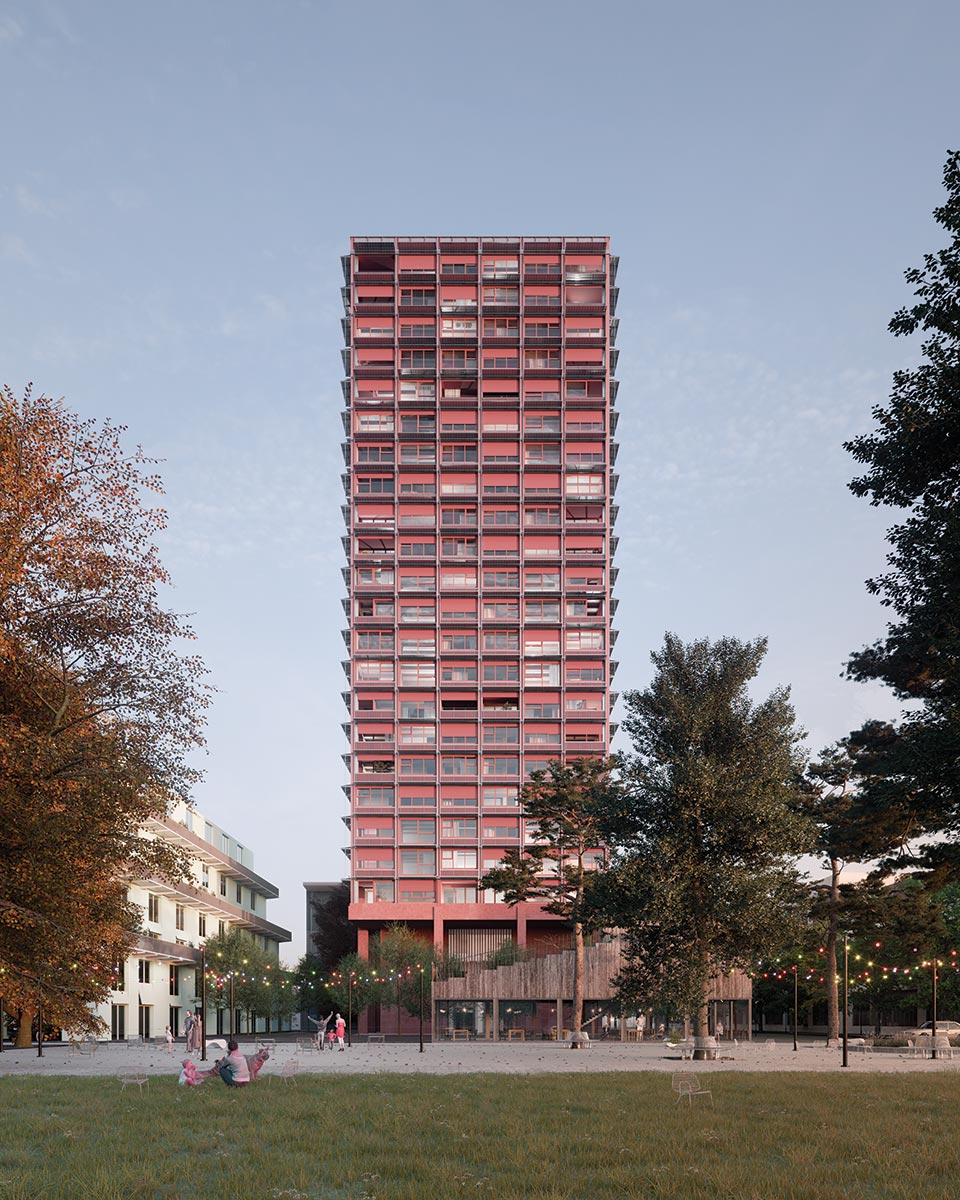
Images © Studio Blomen
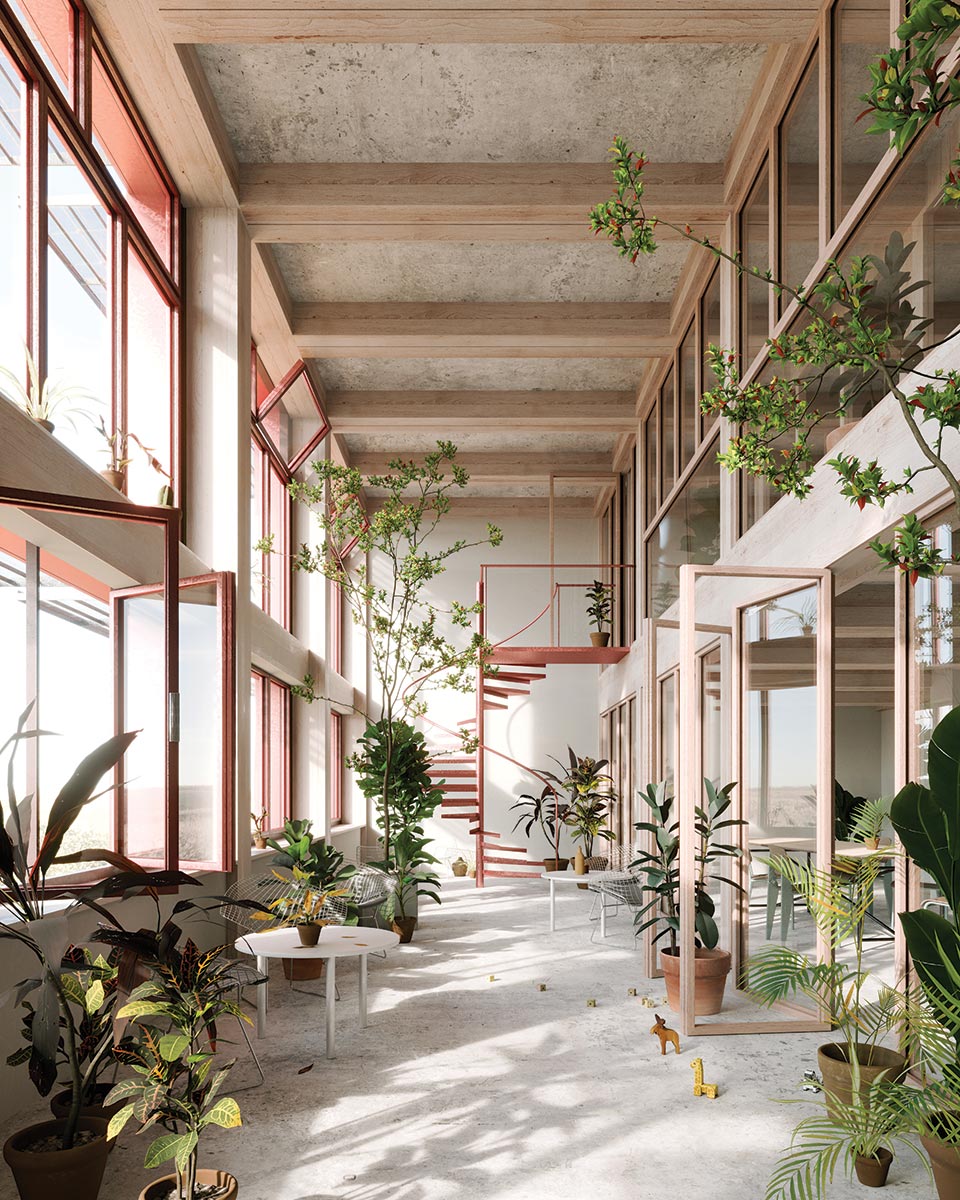
Image © Studio Blomen
ATLASSIAN
Australian software company Atlassian is building a new headquarters near Sydney’s Central Train Station. Designed by SHoP, with BVN as executive architect, the nearly 600-foot-tall structure is one of several projects vying to become the world’s tallest hybrid timber skyscraper. Atlassian Central Tower will include a 39-story shaft rising from a podium, a concrete core, and a steel exoskeleton. Within that framework, floors will be organized as four-story “habitats,” each a freestanding assemblage of glulam columns and beams and CLT floor slabs. Due to structural requirements and the need for large production volumes, these mass-timber components will be sourced from Europe, according to the architects. The hybrid approach is expected to produce a building with half the embodied carbon of a conventional skyscraper. It will be powered 100 per-cent by renewable energy, including electricity generated by facade-integrated photovoltaic panels. The project is targeting 5.5 out of six possible stars from the National Australian Built Environment Rating System (NABERS). Excavation began earlier this year, and steel erection for level 1 is slated to start in 2024. JG
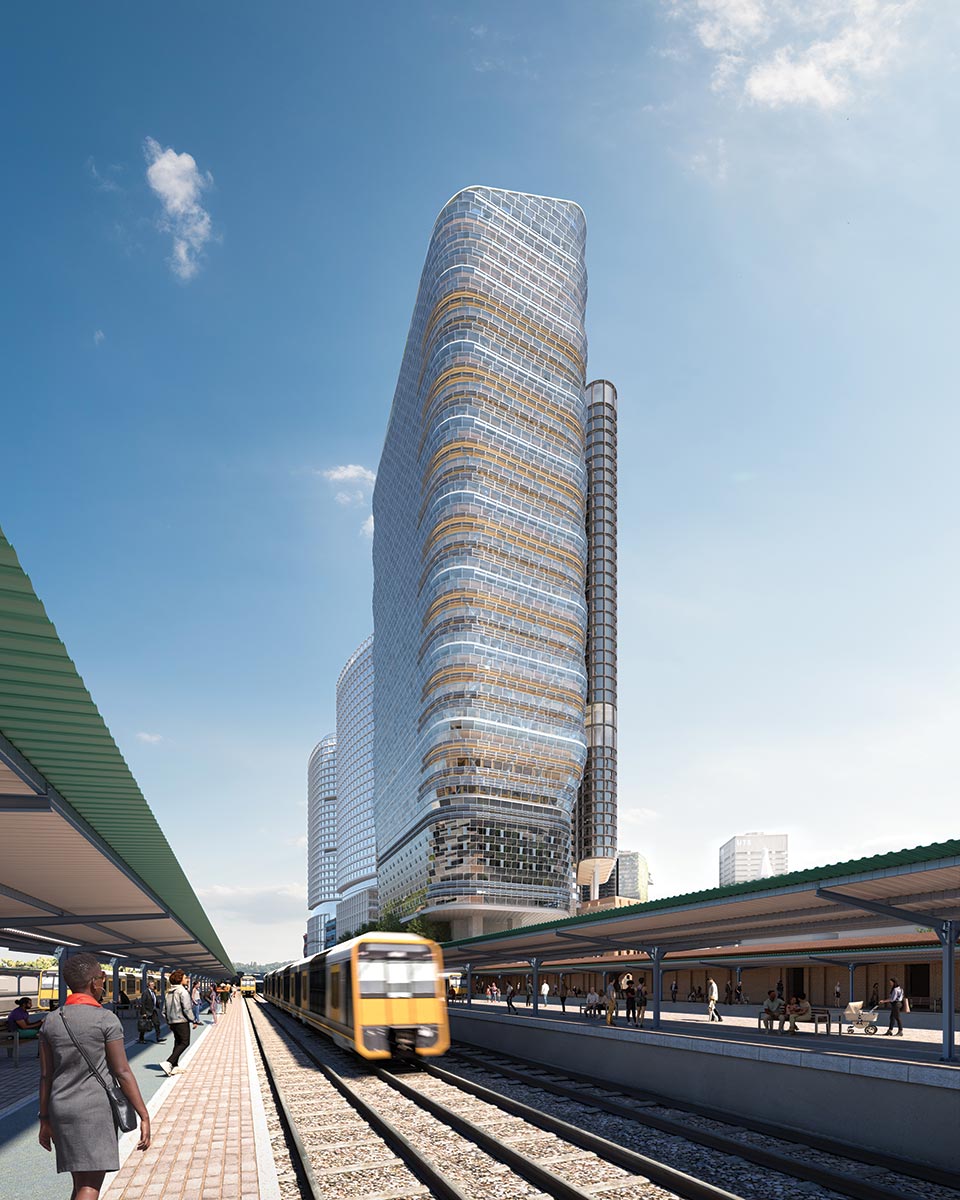
Photo © SHoP Architects
ZURICH AIRPORT
After a two-stage international design competition to overhaul Zurich Airport’s main terminal, Bjarke Ingels Group (BIG) and HOK were awarded the project in June of 2022. With an expected completion date of 2032, the winning redesign of the aging structure, originally built in the 1950s, is titled Raumfachwerk (or “space frame”) and will be constructed primarily with locally sourced timber. The ground-up renovation will consist of a seven-story central hub—with a new air-traffic-control tower, retail, and airport services for passengers—connecting to a narrow pier with a bevy of new gates and waiting areas. According to BIG principal Bjarke Ingels, the project is both “rooted in tradition and committed to innovation.” Its timber framing is an homage to Swiss architectural tradition, while its roof, which extends from the central hub through the length of the pier, will be entirely clad in solar shingles. PS
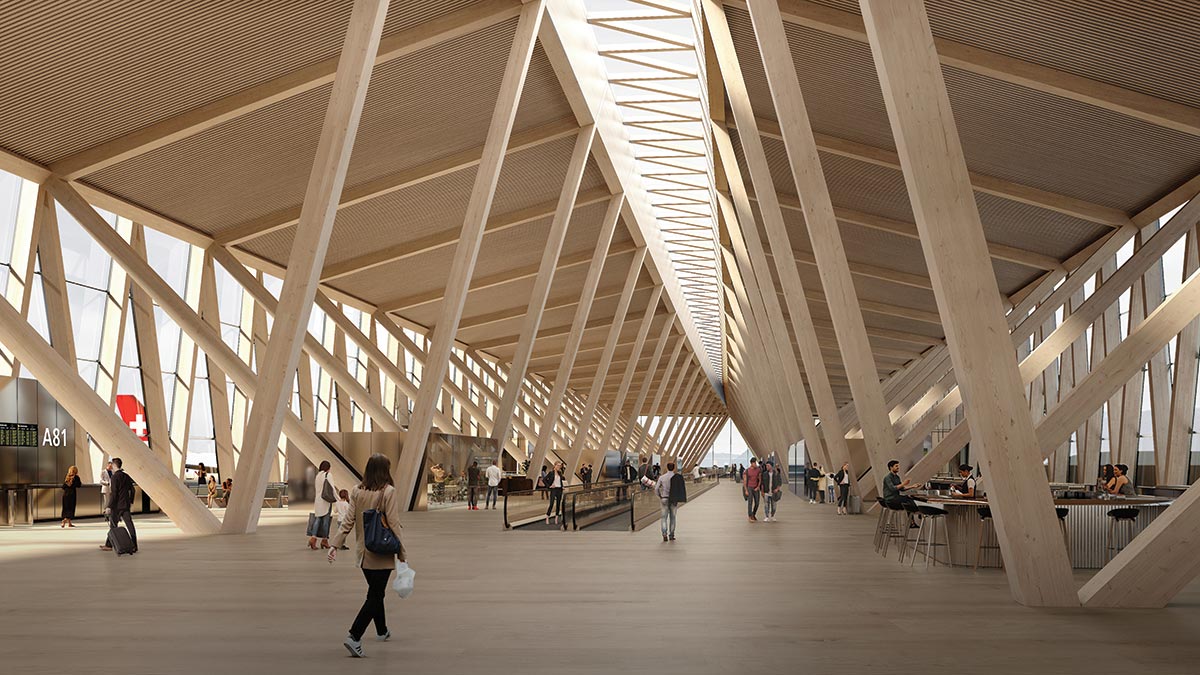
Image courtesy BIG
Glossary of Terms
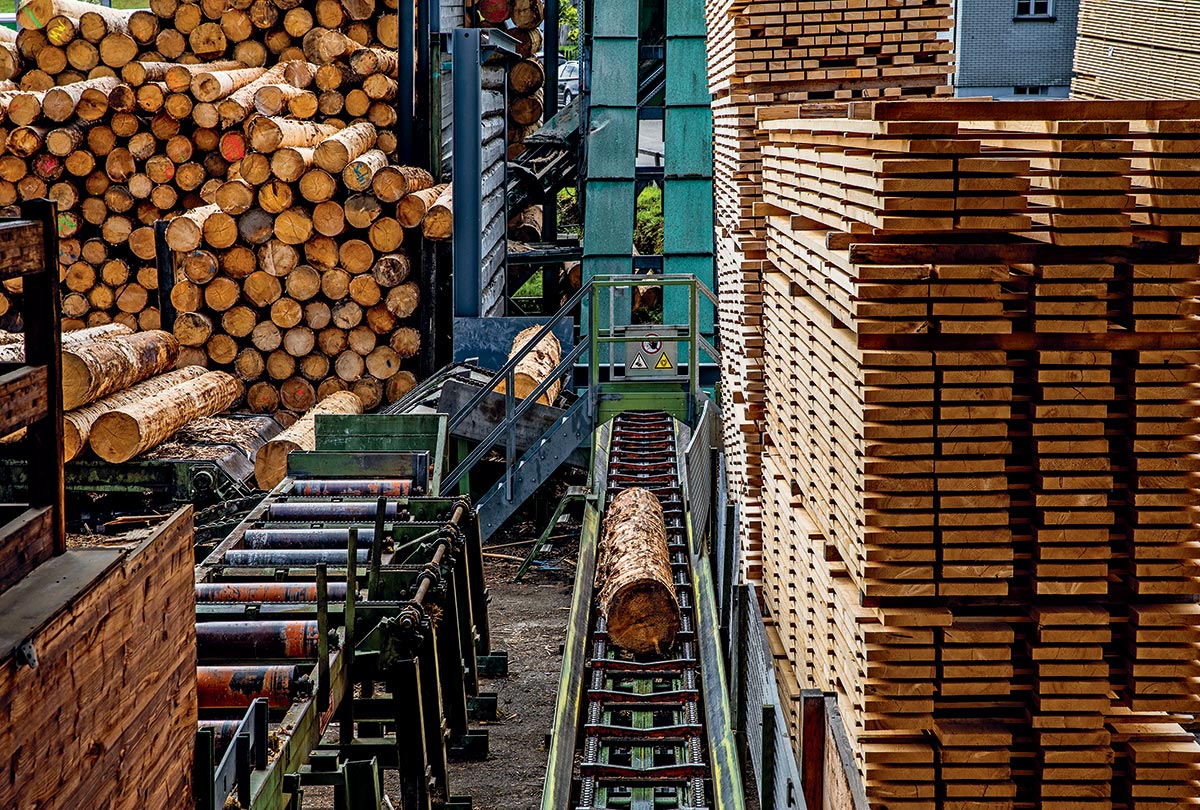
Photo © Stephan Rappo
biogenic carbon
The carbon in wood, paper, grass trimmings, and other organic matter removed from the atmosphere by photosynthesis, which will ultimately be returned to the atmosphere through burning or decay.
cross-laminated timber (CLT)
An engineered-wood panel consisting of layers of lumber stacked with the grain at 90-degree angles and glued together with structural adhesives. Applications include floor slabs, walls, and roofs (A).
dowel-laminated timber (DLT)
A mass-timber product made of dimensional softwood lumber stacked and friction-fit together with hardwood dowels. Although similar to nail-laminated timber, because the panels are made without nails or screws, they are safer to mill and cut. The panels can be used in flooring, roofing, and wall applications (B).
embodied carbon
The greenhouse gases emitted during the manufacturing, installation, maintenance, and disposal of building materials.
Forest Stewardship Council (FSC)
An international nongovernmental organization that oversees certification programs for forest management and wood and paper products.
glue-laminated timber (glulam)
An engineered-wood product commonly used for beams and columns. Laminations are glued together with their grains running parallel to the member’s length and are jointed end to end, allowing for long spans (C).
heavy timber
A traditional construction method in which the primary load-bearing system is made of large wood members.
laminated-veneer lumber (LVL)
n engineered-wood product manufactured from multiple thin layers of veneer that are aligned with the length of the finished lumber. It is often used for headers, beams, and rim board.
life cycle assessment (LCA)
A standard approach to quantifying the environmental impacts of a product or process during its entire life cycle, from the extraction of raw materials to disposal.
mass-plywood panels (MPP)
A large-scale structural panel made from wood veneers. This “super plywood” is manufactured of thin sheets of wood laid down in an alternating pattern with resin applied between each layer.
mass timber
A construction system in which the load-bearing elements are made of engineered components formed by laminating or fastening together layers of wood. These components are often fabricated off-site. .
nail-laminated timber (NLT)
A panel made of dimensional lumber placed on edge and mechanically fastened together with nails or screws, creating a single structural element. It is most commonly used for floor and roof systems (D).
Programme for the Endorsement of Forest Certification (PEFC)
A global alliance of national forest-certification systems.
Sustainable Forestry Initiative (SFI)
A nonprofit organization that provides a certification framework for forest management and wood and paper products.
Wildlands urban interface (WUI)
The zone of transition between wilderness and land developed by human activity, where the built environment meets the natural environment. Human settlements in the WUI are at greater risk of damage due to wildfire.
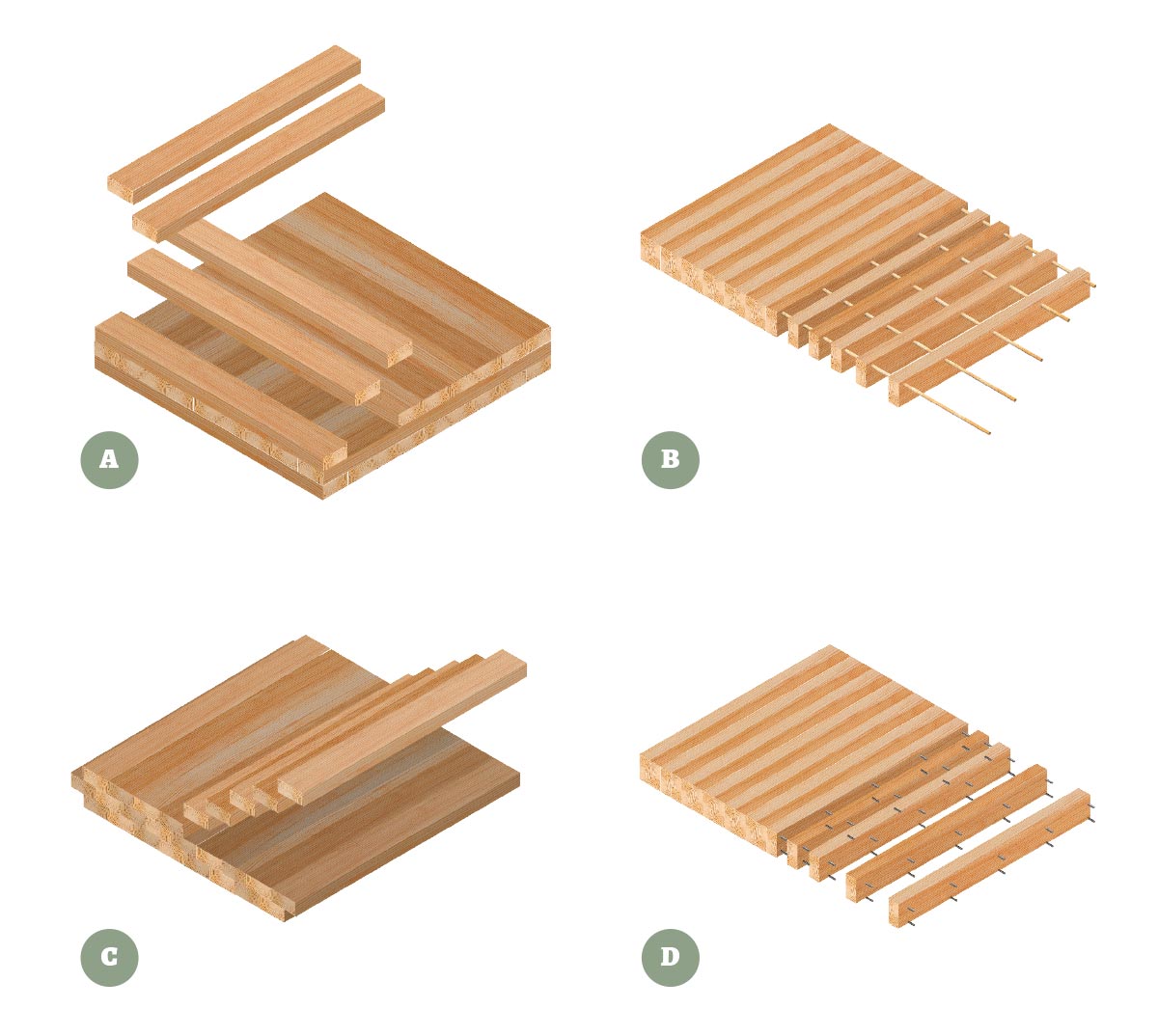
Image © Think Wood
Supplemental Materials:
Mythbusting Mass Timber (pages 12 though 14), by LEVER Architecture and Atelier Ten: Amy Leedham, Jonathan Heppner, Maggie Smith, and Timothy Cooke.






































































